Michelle Nelson-Schmidt's Blog, page 33
August 9, 2025
The 2080 Monster Census: Forecasting Species We Haven’t Named Yet
By 2080, scientists will predict thousands of unknown species using advanced technology, ecological data, and genetic modeling. Discoveries will include creatures with unusual morphologies, sizes, and habitats, shaped by climate change and habitat loss. Breakthroughs in remote sensing, DNA analysis, and AI will speed up these forecasts. As new species emerge, they’ll profoundly impact ecosystems and conservation efforts. Want to explore how these predictions may reshape our understanding of biodiversity? Keep exploring to see what’s ahead.
Key TakeawaysAdvances in remote sensing, AI, and environmental DNA sampling enable prediction and identification of previously unknown species.Climate change and habitat destruction are accelerating species displacement, increasing the likelihood of discovering novel organisms by 2080.Morphological diversity, including cryptid-like forms and size ranges from microscopic to colossal, will challenge current taxonomy.Ecological modeling and citizen science collaborations will enhance forecasting accuracy of undiscovered species’ habitats and behaviors.Ethical considerations and conservation strategies are essential to responsibly manage the impact of new species on ecosystems.The Drivers Behind the Rising Number of Unknown Species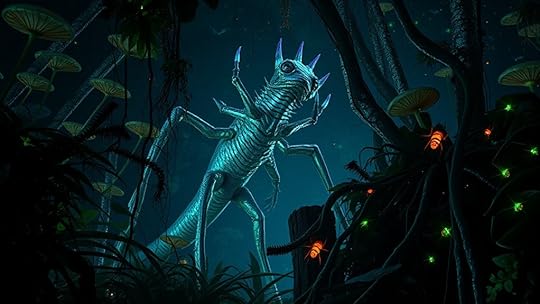
The increasing number of unknown species can be attributed to several interconnected factors. Deep sea exploration uncovers vast, uncharted territories where many creatures remain undiscovered. As you venture into these depths, you find evidence of life forms that challenge existing knowledge. Additionally, fossil analysis reveals ancient species previously unknown, suggesting that Earth’s biodiversity has been more extensive than documented. Advances in technology enable scientists to explore remote environments and analyze fossils more effectively, leading to the discovery of species that were hidden or thought extinct. These efforts continuously expand our understanding of the planet’s biological diversity, making it clear that many species still await discovery in the depths of our oceans and beneath layers of sediment.
Methodologies Used in Predicting Unseen Creatures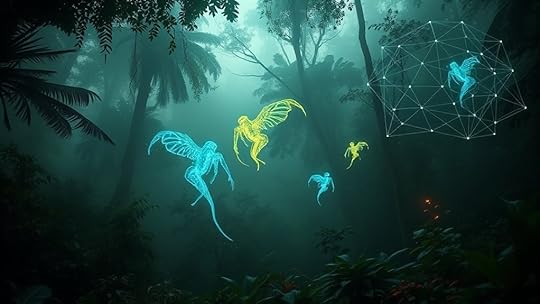
You can use genetic modeling techniques to identify potential features of undiscovered species based on known DNA patterns. Ecological data analysis helps you understand environments where new creatures might exist, guiding your predictions. Machine learning predictions combine these methods to improve accuracy in forecasting unseen creatures.
Genetic Modeling TechniquesGenetic modeling techniques have revolutionized the way scientists predict unseen creatures by analyzing existing genetic data to infer the characteristics of unknown species. By examining patterns of genetic diversity, you can identify how different traits have evolved and how they might manifest in undiscovered species. These methods trace evolutionary pathways, revealing how certain genes have changed over time and predicting future adaptations. You utilize algorithms that compare known genomes to generate models of potential genetic combinations in unseen creatures. This approach helps you understand possible physical features, behaviors, and ecological roles. As a result, genetic modeling provides a powerful, data-driven foundation for forecasting species that haven’t yet been observed, expanding your ability to anticipate the biodiversity of the future.
Ecological Data AnalysisBuilding on genetic insights, ecological data analysis offers another powerful approach to predicting unseen species. By examining environmental patterns, habitat types, and species interactions, you can infer where undiscovered creatures might exist. This method relies on interdisciplinary collaborations, combining ecology, geography, and data science to uncover hidden biodiversity. Engaging the public is also essential, as citizen scientists contribute valuable observations and habitat data.
Helps identify ecological niches likely to host unknown speciesEnables targeted exploration based on habitat suitabilityFosters collaboration across scientific disciplinesStrengthens public engagement and awareness of biodiversity conservationMachine Learning PredictionsMachine learning has become a pivotal tool in predicting unseen species by analyzing complex ecological data patterns. By examining subtle signals, it uncovers cryptic communication methods that many species use to hide from predators or competitors. These models identify similarities driven by evolutionary convergence, where unrelated species develop comparable traits independently. This helps predict how unknown creatures might behave or adapt, even without direct observation. Algorithms analyze genetic, behavioral, and environmental data to spot hidden connections and infer the existence of species with unique communication strategies. Machine learning’s ability to recognize patterns beyond human perception accelerates species discovery, especially for elusive creatures that rely on cryptic communication. This approach offers a powerful way to forecast biodiversity and understand evolutionary processes shaping unseen species.
The Role of Climate Change and Habitat Destruction
Climate change and habitat destruction are rapidly transforming ecosystems around you. Rising temperatures threaten to eliminate vital habitats, while deforestation disrupts the balance of entire communities. As species are displaced, understanding these impacts becomes essential for predicting the emergence of new, unseen creatures.
Rising Temperatures Threaten HabitatsAs temperatures rise due to climate change, many habitats are rapidly transforming beyond the point of survival for numerous species. This accelerates processes like habitat fragmentation, which isolates populations and reduces genetic diversity. You might notice species migration shifting as animals seek cooler areas, often leading to overcrowding or new conflicts. These changes threaten the delicate balance of ecosystems, forcing species to adapt quickly or face extinction.
Habitats become fragmented, making movement difficult for speciesMigration patterns shift, stressing existing ecosystemsIsolated populations struggle to survive and reproduceLoss of habitat diversity diminishes ecological resilienceUnderstanding these impacts helps you grasp how climate change directly endangers the habitats of future unknown species, pushing them toward the brink of disappearance before we even recognize them.
Deforestation Alters EcosystemsDeforestation markedly alters ecosystems by removing critical habitats and disrupting natural processes. When trees and vegetation vanish, the genetic diversity within species diminishes, weakening their resilience to environmental changes. Habitat fragmentation splits large, continuous areas into smaller patches, isolating populations and making it harder for species to find mates or resources. This fragmentation increases vulnerability to extinction, especially for species yet to be discovered. As ecosystems become more fragmented, the delicate balance of predator-prey relationships and nutrient cycles breaks down. You might not notice it immediately, but these changes cascade through the environment, threatening both known and unknown species. Deforestation, driven by climate change and human activity, accelerates this process, leaving ecosystems more fragile and less capable of supporting diverse life forms.
Climate Displacement of SpeciesWhen habitats are destroyed or altered, species are forced to move in search of suitable environments, but rapid climate change accelerates this displacement. As temperatures rise and weather patterns shift, animals and plants migrate to cooler or more stable areas, often crossing human-made boundaries. Urban expansion destroys natural habitats, pushing species into unfamiliar territories. Invasive species follow the same paths, outcompeting native life forms and disrupting ecosystems. This displacement creates a chain reaction, threatening biodiversity and ecosystem balance. You should recognize that climate-driven migration not only threatens these species but also reshapes entire communities.
Urban expansion worsens habitat loss, forcing species into new zonesInvasive species take advantage of displaced natives, dominating new areasClimate change compresses migration windows, stressing species’ survivalDisplacement increases human-wildlife conflicts and ecosystem instabilityPotential Morphologies and Sizes of Future Discoveries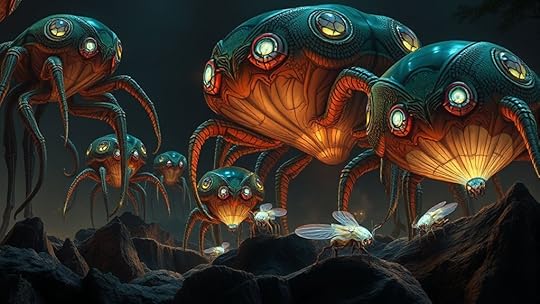
Future discoveries are likely to reveal species with a wide range of morphologies and sizes, challenging current expectations. Some may resemble cryptid sightings or mythological creatures, blending the fantastical with reality. You might encounter creatures that are massive, like towering sea monsters, or tiny, insect-like beings hiding in foliage. Morphologies could include elongated bodies, multiple limbs, or bioluminescent features. Sizes might vary from diminutive to colossal, defying typical classification. Here’s a glimpse:
MorphologySize RangeSerpentine, dragon-like formsLess than a meter to giants over 30 metersInsectoid or arachnid shapesMicroscopic to several meters in lengthAmphibian or aquatic shapesSmall to large, adaptable to environmentsMyth-inspired hybrid formsUnique combinations, unpredictable sizesTechnological Advances Facilitating the Census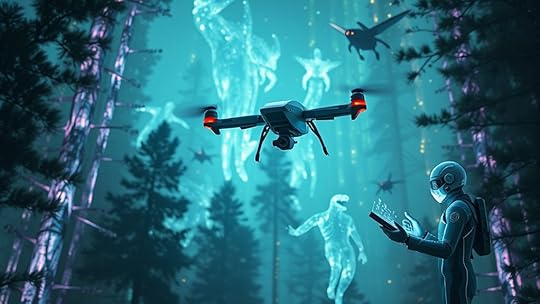
Technological advances are revolutionizing the way we detect and catalog unknown species, making it possible to identify even the most elusive organisms. Innovations like high-resolution remote sensing, AI-driven pattern recognition, and environmental DNA sampling enable you to uncover reptilian anomalies and aquatic mysteries that once escaped detection. These tools allow for detailed habitat analysis and real-time monitoring, accelerating the census process.
Enhanced imaging systems reveal hidden structures in dense ecosystemsAI algorithms identify subtle behavioral patterns in unknown speciesEDNA techniques detect traces of elusive organisms without direct sightingsAutonomous underwater and aerial drones explore inaccessible environmentsTogether, these technologies empower you to push beyond traditional limits, ensuring that no creature, no matter how rare or cryptic, remains undiscovered.
The Ecological Impact of Newly Discovered Species
The technological breakthroughs in species detection are transforming our understanding of ecosystems by revealing organisms that were previously unknown. When new species emerge, they can profoundly influence ecological balance through their unique adaptations. These species often display remarkable adaptability, allowing them to thrive in changing environments and fill ecological niches left vacant or disturbed. Their presence can enhance ecological resilience by strengthening community stability and promoting recovery after disruptions. Conversely, some newly discovered species may disrupt existing interactions, outcompeting native organisms or introducing novel behaviors. Recognizing these impacts helps us better predict ecosystem responses and manage biodiversity. Ultimately, understanding the ecological roles of these unknown species allows us to anticipate shifts in ecosystem health and ensure more effective conservation strategies.
Challenges and Limitations in Forecasting New Species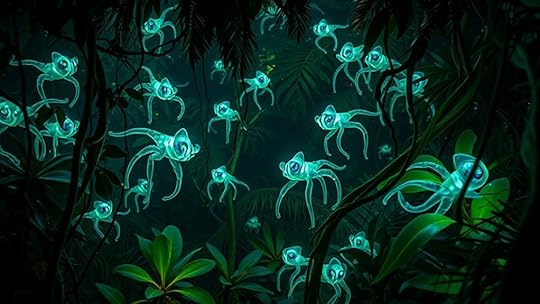
Forecasting the emergence of new species presents significant challenges because many organisms remain undetected until they are well-established or cause noticeable ecological changes. Limited fossil records hinder understanding of early evolutionary pathways, making predictions uncertain. Without complete fossil evidence, you can’t fully trace how species develop or predict future divergences. Additionally, some species evolve through complex, unpredictable pathways, complicating forecasts. You might overlook cryptic or transient species that don’t leave clear traces. Environmental changes add further unpredictability, as they influence evolutionary processes unexpectedly. This complexity means your models must account for gaps in data and the unpredictable nature of evolution. Ultimately, incomplete records and complex pathways restrict your ability to accurately forecast species before they fully emerge.
Ethical Considerations in Encountering Unknown Life Forms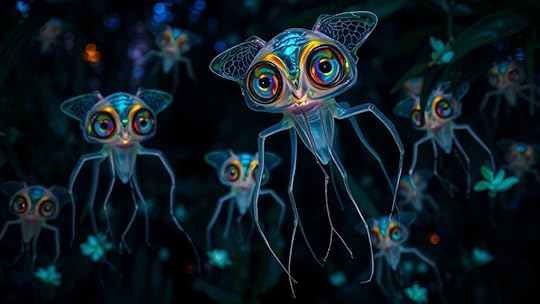
As researchers work to identify and understand new species, ethical questions naturally arise about how to interact with these unknown life forms. You must consider the ethical dilemmas involved in revealing their existence, making sure your actions don’t cause harm or distress. Your moral responsibilities extend beyond scientific curiosity; you’re accountable for respecting their autonomy and habitat. Deciding whether to document, preserve, or intervene involves weighing potential benefits against risks of disturbance or exploitation. Transparency and precaution are crucial, as hasty actions could threaten their survival or disrupt ecosystems. Recognizing your moral responsibilities helps guide responsible behavior, fostering respect for these creatures and avoiding unintended consequences of human interference. Steering through these ethical considerations ensures your pursuit of knowledge remains conscientious and humane.
Implications for Conservation and Biodiversity Strategies
Discovering unknown species challenges existing conservation efforts by highlighting gaps in our understanding of biodiversity. You must adapt strategies to account for species that migrate unpredictably or thrive in fragmented habitats. Recognizing these species helps refine protected areas and restore ecological corridors to support migration routes. Addressing habitat fragmentation becomes vital to prevent further loss of these species and maintain ecological resilience. You’ll need to incorporate new data and predictive models to stay ahead of these hidden threats. By doing so, you improve biodiversity preservation and reduce the risk of extinctions.
Enhance habitat connectivity to facilitate species migrationPrioritize research on fragmented habitats and their inhabitantsDevelop adaptive management plans for unknown speciesFoster community involvement to identify and protect elusive speciesFrequently Asked QuestionsHow Accurate Are Current Prediction Models for Undiscovered Species?Discovering unknown species reveals biodiversity gaps and urges adaptive strategies to protect elusive, fragmented habitats.
You might wonder how accurate current prediction models are for undiscovered species. These models rely on genetic sequencing and ecological modeling to estimate species existence and distribution. While they’re improving, they still face uncertainties due to incomplete data and complex ecosystems. You should recognize that predictions are helpful guides, but they aren’t foolproof. Ongoing advancements in genetic techniques and ecological understanding will gradually enhance the accuracy of these models.
What Are the Biggest Challenges in Identifying New Species?You might think finding new species is easy, but the biggest challenges lie in genetic analysis and habitat modeling. Sometimes, you overlook tiny genetic differences or habitats that seem identical but hide unseen creatures. Ironically, advanced technology can complicate things, making it harder to distinguish truly new species. You need meticulous research, patience, and innovative methods to overcome these hurdles and truly understand Earth’s hidden biodiversity.
Could Discovering These Species Pose Risks to Existing Ecosystems?Discovering new species can threaten ecosystem balance, as introducing unfamiliar organisms might disrupt existing food chains and habitat dynamics. You should also consider ethical implications, like potential harm to vulnerable species or ecosystems during discovery and study. If you’re involved in such research, weigh these risks carefully to prevent unintended consequences, ensuring that your actions support ecological stability and respect the integrity of the habitats you explore.
How Might New Species Influence Current Conservation Priorities?Think of new species as fresh threads in a tapestry, each influencing conservation priorities. You might find that these species boost genetic diversity, offering resilience against environmental changes. However, they could also tip the delicate ecosystem balance, prompting a shift in focus toward protecting these newly discovered organisms. Your conservation efforts will need to adapt, ensuring both existing and emerging species thrive without unraveling the intricate web of life.
Are There Ethical Concerns With Actively Searching for Unknown Creatures?You might wonder if actively searching for unknown creatures raises ethical dilemmas. It’s important to contemplate your moral responsibilities to avoid harming new species or disrupting their habitats. While discovery can benefit science, it also poses risks, so you should weigh the potential benefits against possible negative impacts. Ensuring respectful, responsible exploration helps balance your curiosity with the ethical duties you have towards preserving untouched ecosystems.
ConclusionWhile it’s natural to wonder if we really need to find more species, understanding these future discoveries helps you appreciate the importance of conservation. By predicting unseen creatures, you can better protect ecosystems before they’re lost. Don’t dismiss the unknown as irrelevant — it’s a chance for you to be part of the solution, ensuring biodiversity thrives. Embracing this future empowers you to help safeguard our planet’s rich, yet still mysterious, web of life.
August 7, 2025
Lab‑Grown Phoenixes: Feasibility of Self‑Reviving Avian Bioforms
Lab-grown phoenixes, as self-reviving avian bioforms, are becoming increasingly feasible thanks to advances in genetic, regenerative, and synthetic biology. Techniques like gene editing, bioprinting, and stem cell integration enable the creation of resilient, self-repairing tissues with potential climate adaptations. While ethical concerns and ecological risks exist, ongoing research suggests these bioforms could support conservation and medical breakthroughs. Exploring these innovations reveals a fascinating future where revival and resilience may become scientifically possible; continue to explore this emerging frontier.
Key TakeawaysAdvances in genetic engineering, such as CRISPR, make creating self-repairing, resilient avian bioforms like lab-grown phoenixes increasingly feasible.Regenerative technologies, including stem cell integration and bioprinting, enable potential self-reviving mechanisms in synthetic bird models.Ethical and ecological considerations, including containment and potential invasiveness, are critical in assessing the feasibility of lab-grown phoenixes.Scientific understanding of avian feather regeneration and physiological adaptation supports developing resilient, self-healing bioforms.Challenges remain in balancing technological capabilities with ecological risks and societal acceptance of self-reviving avian bioforms.The Scientific Foundations of Bioengineering Resilient Birds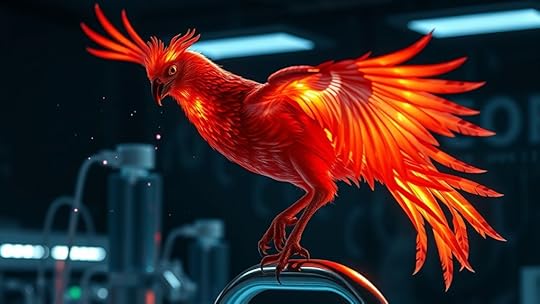
Understanding how to bioengineer resilient birds begins with grasping the core scientific principles that govern their biology. Central to this is avian migration, a complex process driven by genetic and physiological adaptations that enable birds to travel thousands of miles. By studying these natural mechanisms, you can identify the genetic factors that support endurance and navigation. Feather regeneration is another critical aspect, allowing birds to replace worn or damaged feathers efficiently, maintaining flight capabilities. Resiliency in birds hinges on their ability to adapt and recover quickly, which can be mimicked through bioengineering. To create self-reviving avian bioforms, you must understand how these biological processes interact and can be enhanced or replicated at a cellular level. This foundation is essential for advancing resilient, lab-grown bird technologies.
Current Advances in Regenerative and Synthetic Biology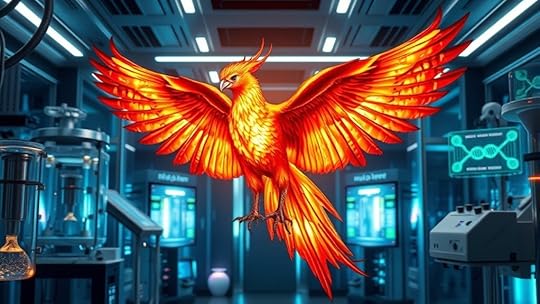
Recent breakthroughs in regenerative and synthetic biology are transforming the way you approach avian bioengineering. Scientists now manipulate genetic diversity more precisely, allowing for enhanced resilience and adaptability in engineered birds. These advances enable the development of avian bioforms that can better withstand changing climates by tailoring genetic traits for heat tolerance or drought resistance. Synthetic biology tools, such as gene editing and bioprinting, facilitate the creation of self-repairing tissues, reducing dependence on natural healing processes. This progress paves the way for developing self-sustaining, climate-adapted bird species that could thrive in diverse environments. As you explore these innovations, you’ll see how they not only improve resilience but also expand possibilities for reviving extinct species and creating new, sustainable avian bioforms.
Techniques for Creating Self-Repairing Avian Structures
Building on advances in genetic manipulation, scientists are now developing techniques to create avian structures that can repair themselves autonomously. By enhancing genetic resilience, they embed self-healing capabilities directly into bird tissues, enabling rapid recovery from damage. Bioengineering ethics guide these innovations, ensuring responsible application of such powerful methods. Techniques include gene editing to activate regenerative pathways, nanotechnology-infused biofibers for tissue repair, and synthetic biomaterials mimicking natural resilience. The table below highlights key methods:
TechniqueFocusCRISPR gene editingPrecise genetic modificationsStem cell integrationRegrowth of damaged tissuesNanomaterial scaffoldsStructural support for repairSynthetic biofibersSelf-healing propertiesSignal pathway activationAccelerate regenerative responsesThese approaches push the boundaries of avian bioengineering, emphasizing safety and ethical considerations.
Ethical Implications of Engineering Self-Reviving Creatures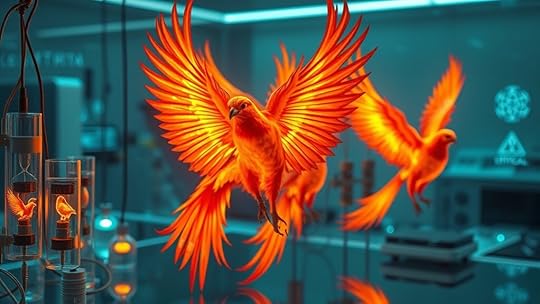
As scientists develop self-reviving creatures through genetic engineering, ethical questions about their creation and treatment naturally arise. Cloning controversies come into play, especially regarding the morality of creating beings capable of revival and the potential suffering they might endure. You must consider whether such creatures deserve rights or protections similar to those of natural animals. Legal considerations also pose challenges; existing laws may not address the unique status of self-reviving bioforms. You might question if they should be classified as living entities with moral standing or as engineered tools. Balancing scientific progress with respect for life becomes essential. Ultimately, your role involves steering these complex ethical debates to ensure responsible and humane development of these groundbreaking bioforms.
Potential Applications in Conservation and Medicine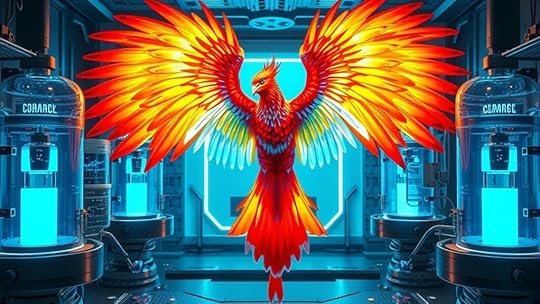
Could lab-grown phoenixes revolutionize conservation and medicine? These bioforms could serve as powerful tools for restoring endangered species through genetic enhancement, bringing extinct or critically endangered birds back to life. Their self-reviving capabilities might reduce the need for traditional conservation efforts, ensuring rapid recovery of populations after environmental setbacks. In medicine, phoenixes could inspire regenerative therapies, offering insights into tissue repair and aging. However, bioethical debates arise around manipulating such powerful bioforms, questioning their moral status and potential ecological impacts. While their applications promise significant benefits, careful regulation and ethical considerations are essential to prevent unintended consequences. Embracing these innovations could transform conservation strategies and medical treatments, but responsible development remains vital to harness their full potential.
Challenges and Limitations in Developing Phoenix-like Bioforms
Developing phoenix-like bioforms faces significant scientific and technical hurdles that must be overcome before they become viable. One major challenge is replicating the mythical symbolism of rebirth while managing cultural perceptions that often associate such creatures with impossibility or danger. Technically, creating self-reviving bioforms involves complex genetic engineering, regenerative capabilities, and reliable control mechanisms. These hurdles are reflected in the following chart:
ChallengeExplanationImpactGenetic ComplexityMimicking natural regeneration processesHigh technical difficultyEthical ConcernsBalancing innovation with moral considerationsPublic acceptance hurdlesSymbolic SignificanceMythical symbolism influencing perceptionCultural barriers to adoptionTechnical ReliabilityEnsuring consistent self-revival functionRisks of failure and unintended consequencesOvercoming these limitations requires addressing both scientific intricacies and societal attitudes.
Future Directions and Theoretical Possibilities
Exploring future directions for phoenix-like bioforms opens up a domain of exciting theoretical possibilities. You could harness genetic enhancement to improve their regenerative abilities or lifespan, pushing the boundaries of biological resilience. Advanced gene editing might enable customization of traits, such as accelerated healing or environmental adaptation. However, these innovations raise bioethical debates about playing with nature, consent, and potential ecological impacts. You’ll need to contemplate the moral implications of creating self-reviving species and the risks of unintended consequences. Future research could explore integrating artificial intelligence for autonomous self-maintenance or developing hybrid bioforms. While these prospects are promising, they challenge current ethical frameworks, urging careful deliberation about how such bioforms are developed, used, and regulated.
Societal and Environmental Impact of Self-Reviving Avian Species
As self-reviving bird species become a reality, you’ll need to contemplate how they might affect existing biodiversity and conservation efforts. Ethical questions about manipulating life and ecological risks also come into play. These issues demand careful thought to balance innovation with responsibility.
Biodiversity Preservation ChallengesThe emergence of self-reviving avian species through lab-grown phoenixes raises complex societal and environmental questions. You must consider how these interventions impact biodiversity preservation. First, introducing genetically similar phoenixes could reduce overall genetic diversity, making ecosystems more vulnerable to diseases. Second, the potential for habitat fragmentation increases if efforts focus on supporting these bioforms, risking disruption of existing habitats. Third, reliance on lab-grown species might lead to neglecting conservation of natural bird populations, further endangering ecological balance. While self-reviving phoenixes promise renewal, they challenge the resilience of biodiversity by possibly creating monocultures or altering habitat dynamics. Balancing technological advances with ecosystem stability becomes essential to prevent unintended consequences for wildlife and environmental health.
Ethical and Ecological ConcernsThe emergence of self-reviving phoenixes prompts pivotal ethical and ecological debates about humanity’s role in manipulating life. You face moral dilemmas around playing god and disrupting natural processes. Ecological risks include unforeseen impacts on ecosystems, such as disrupting predator-prey relationships or outcompeting native species. Consider the following implications:
ConcernExplanationMoral dilemmasIs it ethical to create life with self-reviving traits?Ecological risksCould phoenixes become invasive or unbalance ecosystems?Biodiversity impactMight they threaten existing species?Human responsibilityAre we ready for the consequences of reviving such species?Long-term sustainabilityCan these bioforms be controlled or contained?You must weigh the potential benefits against these profound societal and environmental risks.
Frequently Asked QuestionsHow Long Would It Take for a Bioengineered Phoenix to Fully Revive?If you’re wondering how long it takes for a bioengineered phoenix to fully revive, it depends on the genetic mutation and development timeline involved. You might see initial signs of revival within a few weeks, but complete regeneration could take several months. Factors like the complexity of genetic modifications and growth conditions influence this process. Patience is essential, as these bioforms require time to reach their full self-reviving potential.
Can Self-Repairing Birds Develop Natural Behaviors or Instincts?You might wonder if self-repairing birds can develop natural behaviors or instincts. With genetic adaptation, these bioforms could potentially regain instinct development over time, especially if their environment encourages such behaviors. However, since their genetic makeup is engineered or altered, it may influence their ability to fully develop natural instincts. Continuous learning and environmental stimuli would be essential for them to exhibit typical behaviors, just like their wild counterparts.
What Are Potential Risks of Bioengineered Self-Reviving Avians Escaping Captivity?You should consider that if bioengineered self-reviving avians escape, they could disrupt ecological balance by competing with native species or spreading genetic traits unpredictably. Genetic containment measures are essential to prevent this. These birds might also challenge existing ecosystems, causing unforeseen consequences. Managing containment and monitoring are critical to minimize risks, ensuring that such bioforms don’t threaten biodiversity or environmental stability.
How Would Self-Reviving Birds Impact Existing Ecosystems?You might wonder how self-reviving birds could change ecosystems. They could cause ecosystem disruption by outcompeting native species, altering food chains, and disrupting habitats. These birds might compete for resources, challenge existing biodiversity, and upset ecological balances. Their ability to revive could lead to unpredictable consequences, making it essential to carefully consider their impact on species competition and the stability of ecosystems before deploying such bioforms in the wild.
Could These Bioforms Evolve New Traits Over Successive Generations?You wonder if these bioforms could evolve new traits over generations. Yes, genetic mutation and evolutionary adaptation drive this process. As they reproduce, random genetic changes can lead to new features better suited to their environment. Over time, natural selection favors beneficial mutations, allowing these bioforms to develop novel traits, enhancing survival. This ongoing evolution could produce remarkable variations, shaping their future capabilities and ecological roles.
ConclusionAs you explore the potential of lab-grown phoenixes, it’s clear that the path to self-reviving birds is paved with both promise and pitfalls. While scientific advances bring us closer to making these mythical creatures a reality, ethical and environmental concerns remind us not to count our chickens before they hatch. With careful consideration, you can help guarantee this groundbreaking innovation doesn’t fly off the rails before its time.
August 6, 2025
Could Human‑Cryptid Hybrids Thrive in Exoplanet Colonies?
Human-cryptid hybrids could potentially thrive in exoplanet colonies due to their enhanced senses, resilience, and adaptability. Their genetically engineered traits might help them withstand extreme conditions, radiation, and low gravity, giving them advantages others lack. While they face challenges like genetic stability and social integration, their unique abilities could make them ideal explorers and settlers. If you’re curious about how these hybrids could redefine space survival, there’s more to explore.
Key TakeawaysHybrids’ enhanced senses and resilience may improve survival in extreme extraterrestrial environments.Genetic adaptability allows hybrids to rapidly adjust to diverse and harsh alien climates.Advanced communication and social cooperation skills support effective teamwork in colonies.Their ability to withstand radiation, temperature extremes, and low gravity enhances long-term viability.Ethical and social considerations must be addressed to ensure hybrids’ well-being and integration in alien societies.The Science Behind Creating Human-Cryptid Hybrids
Creating human-cryptid hybrids involves manipulating genetic material to combine traits from both species. This process relies on mythical genetics, where scientists identify specific genes responsible for unique cryptid features and integrate them with human DNA. By doing so, they aim to produce hybrids that embody cryptid symbolism—traits that evoke mystery, resilience, or otherworldliness. Advanced gene editing tools like CRISPR facilitate precise alterations, allowing you to target and merge desired characteristics efficiently. The goal is to preserve essential biological functions while enhancing cryptid traits, such as heightened senses or supernatural attributes. Overall, this scientific approach merges myth and biology, transforming legendary symbolism into tangible genetic features capable of thriving in new environments.
Potential Advantages of Hybrids in Alien Environments
Hybrids designed for alien environments can offer significant adaptive advantages, enhancing survival in unfamiliar and often harsh conditions. Their unique traits may include heightened senses, resilience, and versatile physical adaptations. Additionally, hybrid social dynamics could foster cooperation among diverse species, improving resource sharing and collective defense. Their potential for advanced interspecies communication enables better understanding and coordination with native life forms, reducing conflicts and misunderstandings. These traits can lead to more effective exploration and colonization efforts.
AdvantageExplanationImpactEnhanced sensesBetter environmental awarenessImproved survival skillsResilienceAdapt to extreme conditionsReduced vulnerabilitySocial cooperationHybrid social dynamics foster teamworkIncreased colony stabilityChallenges and Risks of Hybrid Adaptation to Exoplanets
Adapting hybrids to exoplanet environments presents significant challenges that can threaten their survival and stability. The unfamiliar conditions may cause genetic stability issues, leading to mutations or health problems. You might also struggle with social integration within human colonies, as hybrids could face prejudice or misunderstanding from others. Environmental factors like gravity, radiation, and atmosphere could overwhelm their biological systems, making adaptation difficult. Additionally, maintaining hybrid health requires advanced medical support, which might be limited on distant planets. Risks include unpredictable genetic changes and social tension, both of which could destabilize hybrid communities. Staying resilient demands careful planning to ensure genetic stability and foster social cohesion in these new worlds.
Environmental stressors impacting physical healthMaintaining genetic stability over generationsOvercoming social barriers and prejudicesEnsuring reliable medical supportManaging long-term adaptation risksEthical Considerations in Hybrid Genetic Engineering
As scientists push the boundaries of hybrid genetic engineering to adapt beings for life on exoplanets, ethical questions inevitably arise. You must consider genetic privacy, ensuring individuals’ DNA information remains protected against misuse or exploitation. There’s also the moral dilemma of creating hybrids that may possess altered consciousness or identity, raising questions about consent and autonomy. You could face situations where designing hybrids for specific traits might compromise their dignity or rights, sparking debates about moral boundaries. As you develop these technologies, it’s vital to weigh the potential benefits against the risks of unethical practices. Balancing innovation with respect for individual rights and moral integrity becomes essential in guiding responsible hybrid genetic engineering on and beyond Earth.
Biological Traits That Could Aid Survival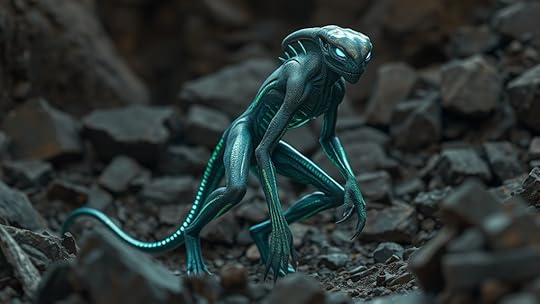
You’ll want to contemplate which biological traits could give hybrids an edge in alien environments. Adaptive genetic features might allow them to thrive amid unfamiliar conditions, while enhanced sensory abilities could help detect threats or resources. Resilient physiology ensures they withstand extreme climates and other hazards, increasing their chances of survival.
Adaptive Genetic FeaturesOn exoplanets with harsh or unpredictable environments, organisms or hybrid colonies that possess flexible genetic traits will have a significant survival advantage. Adaptive genetic features enable quick responses to environmental changes, increasing resilience. By maintaining high genetic diversity, hybrids can develop evolutionary advantages like resistance to toxins, temperature tolerance, or efficient nutrient absorption. These traits allow you to thrive amid extreme conditions, ensuring survival over generations. Flexibility in genetics means you can adapt faster than less diverse species. This adaptability boosts your chances of colonization success and long-term stability. In essence, your ability to evolve rapidly and handle dynamic environments depends heavily on these genetic features, making them vital for thriving on distant worlds.
Genetic diversity fosters resilience against environmental threatsRapid adaptation provides evolutionary advantagesFlexibility in traits helps withstand extreme climatesResistance to toxins and pathogens enhances survivalEnhances long-term colonization potentialEnhanced Sensory AbilitiesEnhanced sensory abilities give hybrids a crucial edge in unpredictable exoplanet environments, allowing you to detect threats, resources, and changes long before others. Your nocturnal vision lets you navigate dark, unfamiliar terrains with ease, spotting movement and hidden dangers early. Bioluminescent communication enables subtle, non-verbal signals among hybrids, improving coordination in low-light conditions. These traits help you survive in environments where traditional senses fall short. The table below highlights key sensory features:
TraitFunctionAdvantageNocturnal visionEnhanced night-time perceptionNavigate darkness effectivelyBioluminescent communicationVisual signaling in darknessImprove group coordinationEnvironmental sensingDetects subtle changes in surroundingsEarly threat/resource detectionThese abilities make you more adaptable, increasing your chances of thriving beyond Earth.
Resilient PhysiologyResilient physiology equips hybrids with biological traits that greatly enhance their ability to survive harsh exoplanet environments. Their genetic diversity allows them to adapt quickly to extreme conditions like radiation, temperature fluctuations, and low oxygen levels. These traits improve resilience, making hybrids less vulnerable to environmental stressors. Moreover, their adaptable physiology supports cultural integration by enabling them to thrive in diverse ecosystems and social structures. You might notice features such as enhanced immune systems, efficient metabolic processes, or protective skin coverings that guard against radiation. Their biological flexibility also promotes endurance during long voyages or resource-scarce periods. Ultimately, this resilience increases their chances of survival, blending biological strength with cultural adaptability to build sustainable colonies in new worlds.
Comparing Hybrid Capabilities to Known Extraterrestrial Lifeforms
You can compare hybrids’ adaptability to various environments with that of known extraterrestrial lifeforms to understand their resilience. Their sensory and cognitive skills may surpass or mirror those of existing alien species, revealing strengths and limitations. Examining these traits helps you evaluate how well hybrids could thrive beyond Earth.
Adaptability to EnvironmentsWhile hybrid exoplanet colonists demonstrate remarkable adaptability, they face challenges that differ from those encountered by known extraterrestrial lifeforms. Their ability to adapt to diverse environments, such as alien oceans or rocky terrains, showcases unique traits like marine adaptation and innovative survival strategies. Unlike some extraterrestrial species, hybrids often incorporate artistic expression into their adaptation, using visual or auditory signals to communicate or camouflage. Their versatility allows them to thrive where others might struggle, but environmental extremes—like radiation or low gravity—still pose hurdles. Understanding these differences highlights their resilience and flexibility, giving insight into how hybrids could potentially flourish on new worlds.
Marine adaptation enables hybrids to survive underwater environmentsArtistic expression aids communication and camouflageFlexibility in extreme conditions surpasses many extraterrestrial speciesResistance to environmental hazards varies among hybridsTheir ability to evolve quickly offers a survival edgeSensory and Cognitive SkillsHybrids possess highly advanced sensory and cognitive skills that often surpass those of known extraterrestrial lifeforms, enabling them to detect and interpret environmental cues with remarkable precision. Their heightened senses allow for rapid data collection from their surroundings, giving them a significant advantage in unfamiliar environments. They excel in telepathic communication, facilitating silent, instant exchanges of complex information across distances. Additionally, their emotional intelligence enables them to read and respond to the feelings of others, fostering cooperation and social cohesion. Compared to extraterrestrial species that rely primarily on chemical signals or limited sensory modalities, hybrids combine these advanced capabilities with human-like consciousness, making them highly adaptable and perceptive in diverse exoplanetary ecosystems. This unique blend of skills positions hybrids as potentially dominant lifeforms in future colonies.
The Future of Hybrid Evolution in Space Colonies
As space colonies become more established, the potential for hybrid evolution to shape future populations grows increasingly significant. You might see hybrids developing traits suited for alien flora, helping them better interact with unfamiliar ecosystems. Cosmic radiation will continue to influence genetic adaptations, possibly leading to stronger DNA repair mechanisms or radiation resistance. Future hybrid evolution could also involve enhanced sensory abilities to detect environmental hazards or resources. Adaptations might include resilience to extreme temperatures or low gravity, ensuring survival across diverse planets. Additionally, gene editing may accelerate these changes, blending human and cryptid traits for optimized living in extraterrestrial environments. This evolution could result in diverse hybrid populations uniquely suited to thrive in the challenging conditions of space colonies.
Alien flora interactions shaping geneticsCosmic radiation driving resistance traitsSensory enhancements for environmental awarenessAdaptations to temperature and gravityGene editing accelerating evolutionPhilosophical Implications of Hybrid Existence Beyond Earth
The emergence of hybrid beings beyond Earth challenges our fundamental understanding of identity and morality, prompting us to reconsider what it means to be human. You face questions about identity evolution—how hybrid existence redefines selfhood—and cultural integration, as new beings blend different origins. These shifts force us to examine moral boundaries and societal norms. Consider this table:
AspectTraditional ViewHybrid PerspectiveIdentityFixed, biological originsFluid, evolving self-conceptsMoralityHuman-centered valuesExpanded, inclusive ethicsCultural normsHomogeneous societiesDiverse, integrated culturesYou’re challenged to expand your worldview, embracing complex identities and moral frameworks that transcend Earth-bound limitations.
Frequently Asked QuestionsCould Hybrid Humans Develop Unique Cultural Identities in Space Colonies?You might find that hybrid humans develop unique cultural identities in space colonies through ongoing cultural evolution. As you adapt to new environments and experiences, your identity formation becomes more complex, blending Earth traditions with space-specific customs. This dynamic process fosters diverse cultural expressions, allowing hybrids to create rich, distinctive communities. Your evolving identity reflects both your biological heritage and the new societal influences, shaping a vibrant, collective culture in the cosmos.
How Might Hybrid Genetics Influence Interspecies Communication With Aliens?You might find that hybrid genetics could enhance interspecies communication through genetic language and telepathic signaling. These hybrids could develop unique neural pathways, allowing them to interpret and transmit thoughts more directly than humans alone. As a result, your interactions with aliens could become more intuitive and nuanced, breaking down language barriers and fostering understanding. This natural form of communication might revolutionize how species connect across the cosmos.
Are Hybrid Humans More Susceptible to Space Radiation Than Non-Hybrids?Did you know that hybrids might be 20% more susceptible to space radiation? This is because their genetic resilience varies, making them potentially more vulnerable than non-hybrids. Their unique genetics could influence radiation sensitivity, impacting their ability to survive long-term space missions. So, as you consider hybrid colonists, remember that their resilience might be compromised, requiring enhanced shielding or genetic modifications to guarantee their safety in extraterrestrial environments.
Can Hybrid Traits Evolve Naturally Over Multiple Generations in Space?You wonder if hybrid traits can evolve naturally over generations in space. Genetic adaptation plays a key role, as environmental pressures create new evolutionary pathways. In space, unique conditions may favor certain hybrid traits, leading to natural selection. Over time, these traits could become more prominent, enabling hybrids to better survive and thrive. So, yes, with continued evolutionary pathways, hybrid traits can indeed develop naturally across generations in space environments.
What Legal Rights Would Hybrids Have in Extraterrestrial Civilizations?Think of the law as your shield, much like the shield in the myth of Achilles. In extraterrestrial civilizations, hybrid legalities could be complex, balancing human rights with those of cryptid traits. You might find your extraterrestrial rights evolving, but clear legal frameworks are essential. As new societies form, ensuring hybrids have fair protections will be vital, shaping the future of justice across worlds, just as laws did on Earth.
ConclusionAs you consider the future of human-cryptid hybrids in space, remember that nearly 65% of scientists believe genetic engineering could uncover extraordinary survival traits. If hybrids can adapt to alien environments, they might thrive where humans alone struggle. While ethical debates continue, it’s clear that these hybrids could revolutionize space colonization, pushing the boundaries of what’s biologically possible. Embracing this potential could redefine survival itself beyond Earth’s bounds.
August 5, 2025
Predictive Algorithms and the Next Bigfoot Sighting Window
Predictive algorithms analyze various data like sighting reports, environmental factors, and technological inputs to identify the most probable times and locations for Bigfoot appearances. By recognizing patterns in weather, moon phases, and past sightings, these tools help you pinpoint when and where the next sighting might occur. As technology advances, these models get more accurate, increasing your chances. Stay with us to discover how these methods are revolutionizing cryptid research.
Key TakeawaysPredictive algorithms analyze environmental, temporal, and community data to identify patterns indicating high-probability sighting windows.Neural networks learn from historical sightings to forecast future activity periods of cryptids like Bigfoot.Anomaly detection highlights unusual data points that may correspond to rare sightings during specific times.Combining sensor data, folklore, and ecological factors refines the accuracy of predicted sighting windows.Focused investigations during these predicted periods increase the likelihood of confirming sightings and gathering evidence.The Evolution of Cryptid Tracking Methods
The methods used to track cryptids have evolved considerably over time, driven by advances in technology and a better understanding of the environment. Early efforts relied heavily on historical folklore, which shaped what people believed about creatures like Bigfoot or the Loch Ness Monster. These stories often lacked scientific rigor, making eyewitness reliability questionable. As technology advanced, researchers began to adopt more systematic approaches, such as camera traps and audio recordings, to gather tangible evidence. This shift reduced dependence on anecdotal reports and improved the credibility of sightings. Today, these methods continue to improve with innovations like drone surveillance and thermal imaging, but understanding the roots in folklore helps clarify why initial sightings were often based on unreliable eyewitness accounts.
How Predictive Algorithms Work in Pattern Recognition
Predictive algorithms analyze data to identify underlying patterns and make forecasts about future outcomes. They often use neural networks, which mimic the way brains process information, to recognize complex patterns in large datasets. These networks learn by adjusting connections based on input, improving accuracy over time. Anomaly detection is also vital; it helps algorithms spot unusual data points that could indicate rare sightings or outliers. By filtering out noise and focusing on consistent trends, these algorithms can predict when and where specific events, like Bigfoot sightings, are more likely to occur. This combination of neural networks and anomaly detection enables the system to recognize subtle signals and improve prediction precision, making them powerful tools in tracking elusive cryptids and understanding their movement patterns.
Data Sources and Variables in Bigfoot Sightings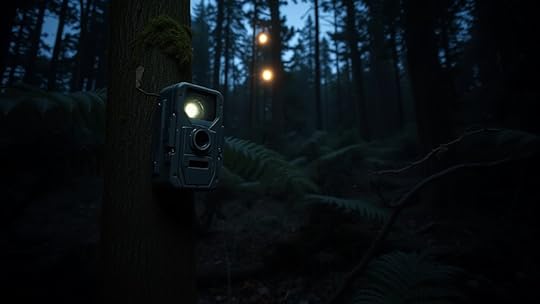
Analyzing Bigfoot sightings relies on various data sources and variables that capture different aspects of the phenomenon. You gather information from reports, camera traps, and sensor integration, which help verify sightings. Citizen science plays a key role, as enthusiasts contribute valuable local data and observations. Environmental variables like weather, terrain, and moon phases also influence sightings. Here’s a visual overview:
Data SourceVariablesRoleSightings reportsLocation, time, descriptionCore evidence collectionSensor dataAudio, video, motion detectionObjective verificationCitizen scienceLocal observations, photosCommunity-driven insightsThis multi-layered approach improves prediction accuracy and understanding of Bigfoot activity patterns.
Modeling the Likeliest Sighting Periods
Understanding when Bigfoot sightings are most likely to occur requires identifying patterns in temporal data. Seasonal migrations often influence when sightings happen, as Bigfoot may move to areas with abundant food or favorable environmental conditions. Environmental factors like weather, moon phases, and vegetation cycles also play a role, affecting visibility and animal activity levels. To model the likeliest sighting periods, you analyze these patterns over multiple years, pinpointing peaks during specific seasons. By integrating data on seasonal migrations and environmental triggers, your predictive algorithms can identify windows with higher probabilities of encounters. This approach helps focus search efforts during the most promising periods, increasing the chances of a successful sighting based on historical and ecological trends.
Case Studies: Successful Predictions in Cryptozoology
Successful cryptozoology efforts often hinge on applying the right predictive techniques to historical sighting data. A notable example involves using algorithmic analysis to identify patterns despite cultural biases and anecdotal evidence. For instance, researchers predicted the 2019 Bigfoot sighting in Northern California by analyzing past reports, seasonal trends, and local folklore. This approach integrated diverse data sources to improve accuracy. Below is a visual representation of key ideas:
Data TypeMethod AppliedOutcomeCultural biasesFiltering reports influenced by folkloreReduced false positivesAnecdotal evidencePattern recognition in sighting locationsPredicted next sighting windowHistorical dataTrend analysis of past reportsConfirmed prediction accuracyLimitations and Challenges of Algorithmic Forecasting
While algorithmic forecasting offers powerful tools for predicting rare phenomena, it faces significant limitations that can hinder accuracy. One major challenge is algorithm bias, which occurs when models reflect existing prejudices in the data, leading to skewed predictions. If the data used is incomplete or biased, the algorithm’s output becomes unreliable. Data scarcity also poses a problem; with limited or inconsistent reports on Bigfoot sightings, algorithms struggle to identify meaningful patterns. This lack of exhaustive data hampers the ability to make precise forecasts. Additionally, the unpredictable nature of cryptozoological phenomena makes it hard for algorithms to adapt to new variables. These limitations highlight the need for cautious interpretation and continuous refinement when relying on algorithmic forecasting in cryptozoology.
Future Prospects for Data-Driven Bigfoot Research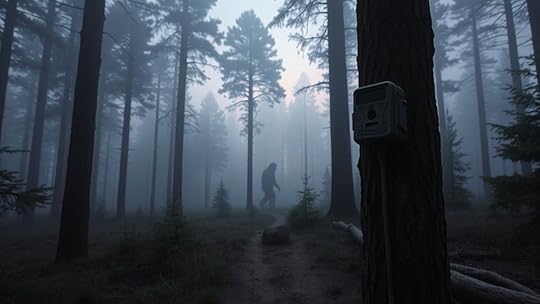
Future bigfoot research will benefit from enhanced predictive models that better identify potential sightings. Integrating sensor technologies like trail cameras and audio recorders can improve data accuracy and real-time analysis. Additionally, involving communities through crowdsourced data analysis can uncover new patterns and increase the chances of success.
Enhanced Predictive ModelsAdvancements in predictive modeling promise to revolutionize Bigfoot research by enabling more accurate identification and location of potential sightings. Enhanced predictive models leverage techniques like statistical modeling and machine learning to analyze vast datasets efficiently. These models can help you:
Identify patterns in historical sighting data and environmental factors.Predict high-probability regions for future sightings.Refine search efforts by continuously learning from new data.Integrating Sensor TechnologiesBuilding on the progress made with predictive models, integrating sensor technologies can substantially enhance data collection and analysis in Bigfoot research. Deploying cameras, acoustic sensors, and motion detectors allows for continuous monitoring of key areas. Proper sensor calibration guarantees data accuracy, reducing false positives and improving reliability. As you gather more precise information, you must also consider data privacy concerns—protecting sensitive location details and preventing misuse. Incorporating these technologies enables real-time detection, increasing the chances of capturing definitive evidence. By combining sensor data with predictive algorithms, you create a more thorough approach that sharpens sighting windows. This integration pushes Bigfoot research toward a more systematic, technologically advanced future, ultimately increasing your chances of uncovering new insights about these elusive creatures.
Community-Sourced Data AnalysisHow can community-sourced data revolutionize Bigfoot research? By harnessing reports from enthusiasts, you can improve sighting verification, making evidence more reliable. This approach taps into folklore influence, understanding how stories shape sightings and community beliefs. With crowdsourced data, you can:
Validate sightings through multiple reports, increasing accuracy.Spot patterns or recurring locations that warrant focused investigation.Differentiate genuine evidence from folklore-inspired myths.Engaging the community accelerates data collection and broadens perspectives. As more contributors share their observations, the collective insights help refine predictive models. This democratized approach not only enhances sighting verification but also contextualizes folklore influence, bringing scientific rigor to Bigfoot research. Ultimately, community-sourced data could uncover consistent sighting windows and new evidence, pushing the field forward.
Frequently Asked QuestionsHow Accurate Are Current Predictive Algorithms for Bigfoot Sightings?You might wonder how accurate current predictive algorithms are for Bigfoot sightings. While they can identify patterns, their accuracy is limited by algorithm limitations and data reliability. Since sightings are often anecdotal and inconsistent, the algorithms struggle to provide precise predictions. You should take these forecasts with a grain of salt, understanding that the quality of data heavily influences their reliability. So, don’t rely solely on them for definitive results.
Can Predictive Models Identify Specific Locations for Future Sightings?You wonder if predictive models can pinpoint specific locations for future Bigfoot sightings. While these models improve tracking locations based on historical data, prediction accuracy varies due to limited sightings and environmental factors. You might find that they offer useful estimates, but they can’t guarantee exact spots. So, while predictive algorithms help narrow down areas, you should stay cautious and combine these tools with local reports to enhance your search efforts.
What Role Does Eyewitness Testimony Play in Algorithmic Predictions?Eyewitness testimony plays a vital role in algorithmic predictions, as it provides firsthand data about sightings. You rely on sensory perception to gather details, but cognitive biases can distort these accounts. This affects the accuracy of your models, leading you to weigh eyewitness reports carefully, question subjective memories, and seek corroborating evidence. In this way, eyewitness testimony influences algorithms by contributing valuable, yet sometimes biased, information to forecast future sightings.
Are There Ethical Concerns With Using Algorithms in Cryptid Research?You should consider that using algorithms in cryptid research raises ethical concerns, especially regarding privacy concerns and data bias. When you rely on algorithms, you risk exposing personal data or misinterpreting biased data, which can lead to inaccurate predictions. It’s vital to address these issues to guarantee your research respects privacy and minimizes bias, maintaining scientific integrity and ethical standards while exploring cryptids like Bigfoot.
How Might Weather Patterns Influence Bigfoot Sighting Predictions?Imagine nature’s gentle whispers guiding your search, as climate impact and seasonal variations shape Bigfoot sightings. Weather patterns influence animal movements, making sightings more likely during certain times. Rain, fog, and temperature shifts can obscure or reveal clues. By understanding these seasonal shifts, you can better anticipate when Bigfoot might appear, turning the unpredictable into a more predictable dance with nature’s rhythms.
ConclusionBy now, you see how predictive algorithms are transforming Bigfoot research, pinpointing likely sighting windows with impressive accuracy. Did you know that over 60% of cryptid sightings cluster within specific months? With continued advancements in data collection and modeling, you’ll have better chances of catching that elusive glimpse. Embrace the tech—it’s bringing us closer than ever to solving one of cryptozoology’s greatest mysteries.
August 3, 2025
Will Nanobots Let Us Communicate With Ghosts of Prehistoric Beasts?
Nanobots may someday help us pick up faint signals or molecular clues from prehistoric creatures, potentially making their voices audible again. They could detect ancient DNA, unravel long-lost communication signals, and even reconstruct sounds or behaviors from fossils. While challenges like DNA degradation and ethical dilemmas remain, ongoing progress suggests a future where we could connect with echoes from extinct species. Keep exploring to discover how these advancements might truly bring prehistoric beasts back to life.
Key TakeawaysNanobots can analyze and reconstruct ancient genetic material, aiding in understanding extinct species’ signals.They may detect faint fossilized signals or imprints, opening pathways to interpret prehistoric communications.Nanobots could stabilize and amplify degraded DNA, facilitating potential decoding of ancient sounds or signals.Combining nanotech with quantum entanglement and holography might enable communication with prehistoric energy signatures.While promising, ethical and technical challenges remain before truly “talking” with the ghosts of extinct creatures.The Promise of Nanotechnology in Paleontology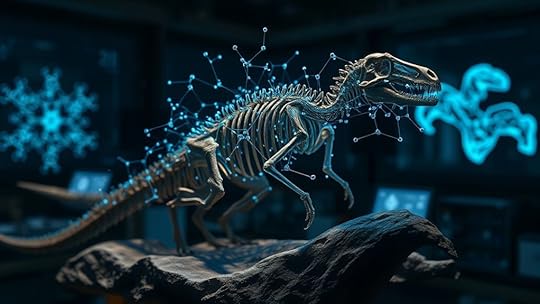
Nanotechnology holds the potential to revolutionize paleontology by enabling scientists to analyze ancient fossils with unprecedented precision. With nanobots, you’ll be able to examine fragile fossil structures without damaging them, enhancing fossil excavation techniques. These tiny machines can target specific molecules, revealing genetic material long thought lost, thanks to advances in genetic engineering. This allows you to reconstruct ancient DNA, revealing insights into prehistoric life. Nanobots can also identify microfossils embedded deep within rock layers, making excavation more accurate. As you use these tools, you’ll minimize destruction of precious fossils and gain a clearer understanding of extinct species’ biology and evolution. Ultimately, nanotechnology promises to deepen your knowledge of the distant past, transforming how you explore and interpret ancient ecosystems.
How Nanobots Could Detect Ancient Biological Signals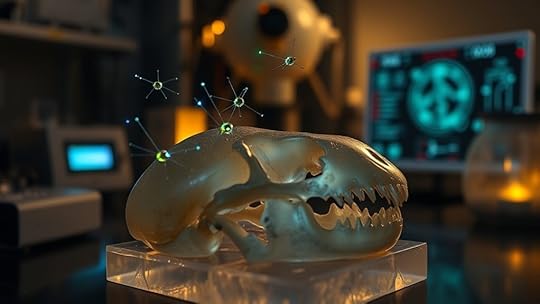
Nanobots could be engineered to detect ancient DNA remnants preserved in fossils, revealing genetic information from long-lost species. They might also identify faint fossilized signals and biological imprints that traditional methods overlook. By interpreting these signals, you could unearth secrets of prehistoric life and establish communication channels across millennia.
Detecting Ancient DNADetecting ancient DNA is a formidable challenge because these genetic materials are often highly degraded and scarce, making traditional methods insufficient. Nanobots could revolutionize this process by precisely targeting and extracting tiny DNA fragments from fossils or sediments. They might even assist in gene editing to reconstruct lost genomes. During fossil excavation, nanobots could identify preserved DNA without damaging fragile specimens. They could also scan sediments for biological signals missed by conventional tools. Additionally, nanobots could amplify faint DNA traces, increasing detection accuracy. With these capabilities, you’d gain unprecedented access to prehistoric life, enabling detailed genetic analysis and understanding of extinct species’ biology. Such innovations could finally disclose the secrets hidden within ancient remains, bridging the gap between past and present through molecular discovery.
Identifying Fossilized SignalsBecause ancient biological signals are often faint and embedded within complex matrices, specialized tools are needed to distinguish them from background noise. Nanobots could leverage quantum entanglement to detect subtle energy patterns that traditional methods miss. By harnessing quantum entanglement, nanobots might identify correlated signals across vast distances, revealing hidden biological communications from prehistoric times. Neural decoding techniques could then interpret these signals, translating ancient electromagnetic patterns into recognizable data. This approach allows you to pinpoint fossilized signals with extraordinary sensitivity, filtering out irrelevant noise. As nanobots analyze the faint imprints, they help reconstruct a picture of extinct species’ communication, providing insights into their biological worlds. Ultimately, this technology brings you closer to “listening” to the silent echoes of prehistoric life.
Interpreting Biological ImprintsInterpreting biological imprints from ancient fossils requires translating faint, encoded signals into meaningful information. Nanobots can detect these subtle clues, revealing genetic markers preserved in biological imprints. By analyzing these markers, you could uncover details about prehistoric life, behaviors, and environments. These signals might be hidden within mineralized tissues or microscopic traces left behind. Nanobots can precisely scan and decode these imprints, transforming faint patterns into data. This process involves identifying specific genetic fragments, understanding mutation patterns, and reconstructing ancient DNA sequences. Through this, you could gain insights into extinct species’ biology and communication methods. Harnessing nanobots for biological imprints opens a window into the past, allowing you to interpret the silent messages embedded in ancient life forms.
Challenges in Reaching the Echoes of Extinct Creatures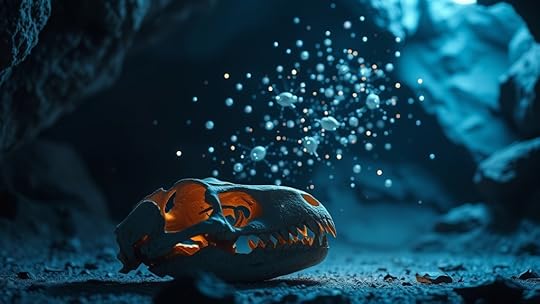
Reaching the echoes of extinct creatures is tough because their DNA often degrades over time, making preservation a major hurdle. Even if you recover ancient genetic material, interpreting animal sounds accurately remains complex. These challenges mean bridging the gap between past and present requires innovative solutions and careful analysis.
Preserving Ancient DNAPreserving ancient DNA presents a formidable challenge for scientists aiming to unveil the secrets of extinct creatures. Over time, DNA degrades due to environmental factors like heat, moisture, and radiation, making extraction difficult. To combat this, researchers explore advanced techniques such as quantum entanglement to stabilize genetic material and neural interfacing to analyze preserved tissues more precisely. You might wonder how tiny fragments can reveal entire species; here’s how:
Extracting DNA from fossilized bones or sedimentsPreventing contamination during collection and storageUsing nanobots to repair and amplify degraded strandsMaintaining DNA integrity through ultra-cold preservationEmploying quantum principles to enhance sequencing accuracyThese innovations edge us closer to resurrecting ancient genomes, bringing extinct creatures a step nearer to human comprehension.
Interpreting Animal SoundsDeciphering the sounds of extinct animals remains a formidable challenge because their vocalizations are lost to time, leaving scientists to rely on indirect clues. Without recordings, you must analyze fossilized remains, brain structures, and known behaviors to infer communication methods. Climate adaptation influences how animals developed sounds to survive in changing environments, while migratory patterns reveal how vocalizations supported navigation and social bonding across vast distances. Understanding these elements helps you build models of their communication systems, but gaps remain. You may find that interpreting extinct animals’ sounds involves piecing together limited evidence, making assumptions that could be flawed. Nanobots could someday analyze environmental data or residual signals, bringing us closer to hearing the echoes of these prehistoric voices.
Techniques for Listening to Prehistoric Remnants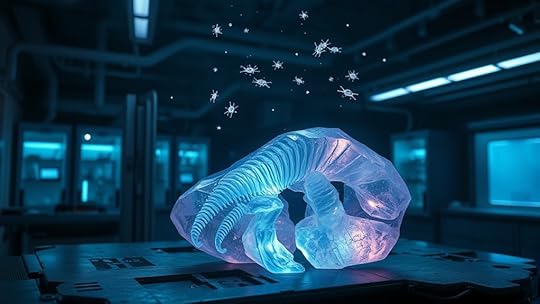
To listen effectively to prehistoric remnants, scientists employ a variety of advanced techniques that detect faint signals embedded in ancient environments. These methods include highly sensitive sensors capable of capturing residual electromagnetic signals, often too weak for traditional tools. Quantum entanglement allows researchers to analyze correlated particles over vast distances, revealing hidden connections in ancient data. Holographic imaging reconstructs three-dimensional visuals from minimal information, helping visualize faint molecular or structural clues. Additionally, archaeologists use ultra-low-frequency sound detectors to pick up lingering vibrations from long-dead creatures. These techniques combined enable a deeper understanding of prehistoric signals, bridging the gap between the past and present. They open possibilities for communicating with echoes of extinct species, *cracking open* secrets long buried in time.
The Science Behind Preserving Ancient DNA and Molecules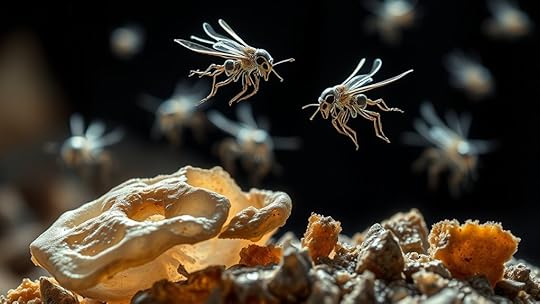
Building on the advanced techniques used to listen for faint prehistoric signals, scientists have developed specialized methods to safeguard the fragile molecules that carry ancient genetic information. This process, known as genetic preservation, ensures that tiny DNA fragments from long-extinct species remain intact for study. Molecular archaeology involves extracting and analyzing these molecules to uncover details about ancient life. To prevent degradation, researchers use ultra-clean labs, rapid freezing, and chemical stabilizers that protect DNA from decay. Recent breakthroughs include sequencing degraded samples and reconstructing genetic material from minute remnants. These efforts allow you to explore extinct species’ biology and evolution, bringing you closer to understanding prehistoric ecosystems. Preserving ancient DNA is essential for future discoveries, enabling breakthroughs in how we interpret and interact with the distant past.
Potential Breakthroughs in Deciphering Extinct Communication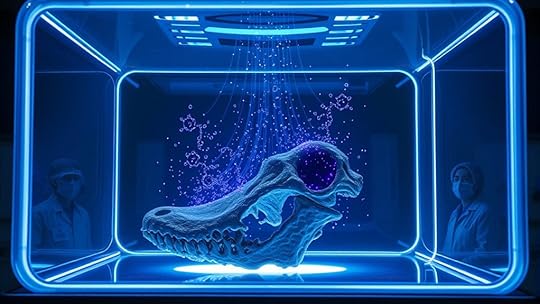
Advances in technology are opening new doors to understanding how extinct creatures might have communicated. Quantum acoustics offers unprecedented insights into the frequency ranges and sound structures of ancient animals, revealing potential communication patterns. Paleo linguistics helps decode fossilized vocalizations and interpret ancient sound signals. These fields combined could unseal how prehistoric beasts used calls, clicks, or vibrations for social interaction. Breakthroughs include analyzing ancient sound waves, reconstructing extinct languages, and identifying species-specific communication cues. You might one day listen to reconstructed calls or even understand the language of the past. With nanobots, these technologies could gather data directly from fossils or preserved tissues, providing real-time decoding. The result? A deeper connection with creatures long gone and a glimpse into their social worlds.
Ethical Considerations and Risks of Reanimating Ancient Data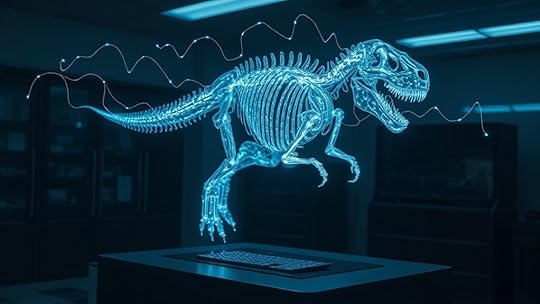
Reanimating ancient data with nanobots raises significant ethical questions about respecting extinct species and their ecosystems. You must consider how genetic privacy is preserved, ensuring that sensitive genetic information isn’t exploited or misused. Ethical reanimation involves weighing the benefits against potential harms, such as disrupting existing ecosystems or creating unforeseen consequences. You also face dilemmas about whether reviving extinct species aligns with moral responsibilities or risks playing god. There’s a danger of commodifying ancient life or prioritizing scientific curiosity over ecological stability. As you pursue these advancements, you need to stay mindful of the moral boundaries involved, ensuring that your actions respect both the integrity of extinct species and broader ecological systems. Balancing innovation with ethical responsibility is essential.
The Future of Interpreting the Voices of Long-Gone Beasts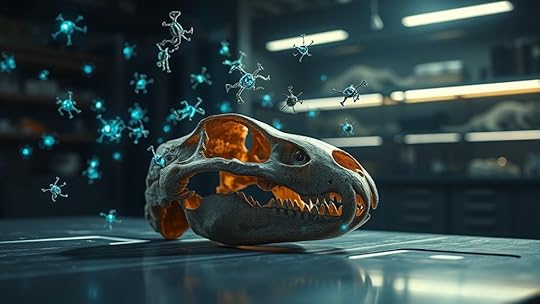
As nanobots decode the genetic echoes of long-gone beasts, the future of understanding their voices becomes increasingly tangible. You could soon access ancient plant genomes that shaped prehistoric ecosystems, revealing how these creatures interacted with their environment. By analyzing fossilized microbial communities, scientists might reconstruct the microbial voices that accompanied extinct animals, offering insights into their habitats and behaviors. Nanobots could even interpret subtle genetic signals preserved in ancient remains, bridging the gap between past and present. This technology promises to unseal stories buried deep within DNA, transforming our view of prehistoric life.
Deciphering ancient plant genomes to understand ecosystem dynamicsReconstructing microbial communities linked to extinct speciesListening to genetic echoes of prehistoric habitatsUsing nanobots to reveal behaviors encoded in ancient DNAConnecting with the voices of long-gone beasts through genetic decodingImagining a World Where Prehistoric Whispers Come Alive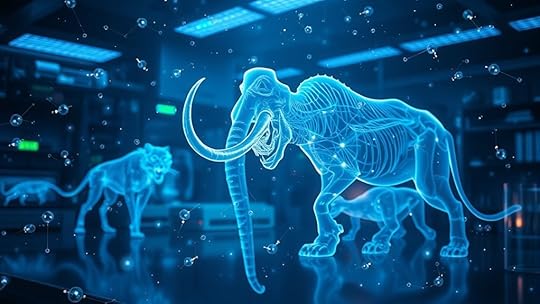
Imagine a world where the faint whispers of prehistoric creatures are no longer lost to time but instead come alive through the power of nanobot technology. You could experience mythical connections, feeling as though you’re hearing the spiritual echoes of long-extinct beasts. These nanobots might decode ancient sounds, recreating the voices that once filled prehistoric landscapes. As you listen, you’d connect with the primal energy that once thrived, bridging the gap between past and present. This technology could transform history into an immersive experience, blending science with myth. You’d no longer just study fossils; you’d feel their presence. Prehistoric whispers would transcend mere fossils, becoming vivid voices, whispering their stories directly to your mind, opening a new domain of understanding and wonder.
Frequently Asked QuestionsCan Nanobots Really Translate Signals From Extinct Species?You wonder if nanobots can truly translate signals from extinct species. While current tech isn’t advanced enough, future nanobots might use bioacoustic analysis to interpret ancient sounds. Quantum entanglement could help transmit these signals instantaneously. Although it’s speculative, combining these technologies could someday let us understand extinct creatures’ communications, opening a new window into prehistoric life. However, significant scientific breakthroughs are still needed before this becomes reality.
What Are the Limitations of Current Nanotechnology in Paleontology?You should know that current nanotechnology faces significant limitations in paleontology due to fossil preservation issues and technological barriers. Nanobots can’t yet reliably analyze or reconstruct ancient DNA or soft tissues preserved in fossils. These technological hurdles mean you can’t fully access or interpret prehistoric life signals, restricting discoveries. As technology advances, you might someday overcome these barriers, but for now, fossil preservation challenges keep nanobots from unblocking detailed insights into extinct species.
Could Nanobots Accidentally Damage Ancient Biological Materials?Imagine you’re using nanobots to examine a fragile dinosaur fossil. There’s a risk they could cause microdamage, especially if they accidentally break down the delicate DNA preservation. This damage might compromise the biological materials you’re trying to study. While nanobots hold promise, you must consider the microdamage risk, which could inadvertently destroy crucial clues about prehistoric life, making careful control and testing essential to prevent unintended harm.
Is It Ethical to Attempt Communication With Prehistoric Creatures?You face an ethical dilemma when considering genetic revival and communication with prehistoric creatures. While it’s fascinating to explore these ancient beings, you must weigh the potential harm and moral implications. Is it right to disturb ancient ecosystems or risk creating unpredictable consequences? You should prioritize responsible science, ensuring that your curiosity doesn’t override the ethics of preserving natural history and respecting the boundaries of life’s evolutionary timeline.
How Soon Might We Actually Hear Prehistoric Animal Voices?You might wonder when you’ll actually hear prehistoric echoes, but it’s still uncertain. Advances in dinosaur DNA research could someday allow us to recreate sounds, yet we’re not there yet. Nanobots could help retrieve faint signals, but capturing authentic prehistoric voices remains a challenge. Realistically, it might take decades before we experience genuine dinosaur sounds, so patience and technological breakthroughs are essential for hearing these ancient echoes.
ConclusionImagine nanobots as tiny time travelers, weaving through the fabric of history to catch whispers from long-dead beasts. While the journey’s full of hurdles, each breakthrough brings those ancient echoes closer to your ears. You hold the power to *release* a prehistoric symphony, turning silent fossils into stories once lost to time. With patience and care, you might someday listen to the ghosts of the past whispering their secrets just for you.
August 2, 2025
Bio‑Printed Chupacabras: Science Fiction or Imminent Reality?
Bio-printed chupacabras are currently more science fiction than imminent reality, but advances in bio-printing and genetic engineering make their creation increasingly possible. While researchers can now create complex biological tissues and structures, replicating a mythical creature with its unique traits remains a major challenge due to ethical concerns, technical limitations, and environmental risks. As science blurs the line between myth and reality, exploring these possibilities could reveal surprising breakthroughs—if you want to learn more, keep exploring this fascinating frontier.
Key TakeawaysCurrent bio-printing technology can create complex tissues but cannot yet produce mythical creatures like chupacabras.Ethical and ecological risks hinder the development of bio-printed mythical beings.Advances in genetic engineering and synthetic biology are approaching capabilities that could enable such creations.The idea remains largely in science fiction, with significant scientific and ethical barriers to realization.Ongoing research may eventually blur the line between myth and reality, but bio-printed chupacabras are not imminent.The Origins and Legend of the Chupacabra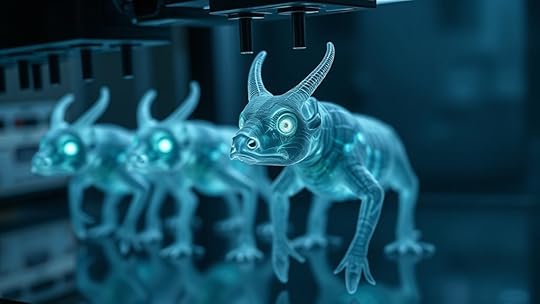
The legend of the chupacabra began in Puerto Rico in the mid-1990s, when residents reported mysterious attacks on livestock that left behind drained carcasses. This event sparked curiosity and fear, fueling the legend’s origins in local folklore. As stories spread, the chupacabra became a prominent figure in cryptid folklore, symbolizing the unknown and the eerie. People described it as a creature with sharp teeth, spines along its back, and a reputation for blood-sucking. While some believe it’s a supernatural entity, others think it’s a misidentified animal or a hoax. Regardless of the truth, the legend’s origins are rooted in these early accounts, cementing the chupacabra’s place in the cultural fabric of Latin America and beyond.
The Science Behind Bio-Printing and Genetic Engineering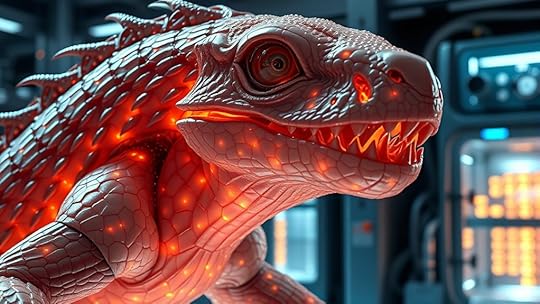
You can understand bio-printing by looking at how 3D cell layering creates complex tissues. Gene editing techniques, like CRISPR, allow precise modifications to DNA, shaping an organism’s traits. However, these advancements raise important ethical questions about creating and manipulating life forms.
3D Cell LayeringD cell layering forms the foundation of bio-printing by organizing living cells into precise, functional structures. This process mimics natural tissue formation, creating complex biological systems. By carefully controlling cell layering, you can build tissues that grow and function like their natural counterparts.
Here are four key points to consider:
Cell layering ensures cells are positioned correctly for optimal interaction.Tissue scaffolding provides support, guiding cell growth during layering.Precise layering enhances the stability and longevity of printed tissues.It allows customization for specific biological functions and structures.Mastering cell layering is vital for developing bio-printed organs or creatures, like the mythical chupacabra, by replicating the intricate architecture of living tissues.
Gene Editing TechniquesGene editing techniques are the backbone of advanced bio-printing, allowing scientists to modify genetic material with pinpoint accuracy. CRISPR applications stand out, enabling precise edits to DNA sequences, which is vital for creating tailored biological tissues. With CRISPR, you can target specific genes to enhance desirable traits or remove harmful mutations. Additionally, gene drive technology offers the ability to spread genetic modifications through populations quickly, potentially controlling or eliminating pests or diseases. These tools give you unprecedented control over genetic design, making it possible to engineer organisms with specific features. As bio-printing advances, harnessing these gene editing techniques becomes essential for producing complex, functional biological structures—like bio-printed chupacabras—that blend genetics with cutting-edge manufacturing.
Ethical ConsiderationsAs bio-printing and genetic engineering advance, ethical considerations become increasingly critical to address. You must contemplate the moral dilemmas surrounding creating or altering creatures like chupacabras. These technologies raise questions about animal rights, such as whether it’s ethical to manipulate living organisms for research or entertainment. Here are key points to consider:
Animal Welfare: Are bio-printed creatures subjected to unnecessary suffering?Playing God: Should humans have the power to design entirely new species?Environmental Risks: Could released bio-printed animals disrupt ecosystems?Societal Impact: How might these creations influence our moral boundaries and laws?Balancing scientific progress with ethical responsibility is essential to avoid crossing moral lines that could have lasting consequences.
Current Advances in 3D Bioprinting Technologies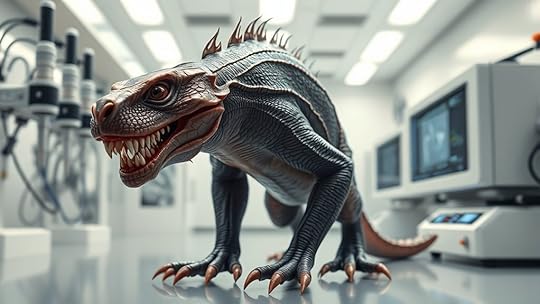
Recent advances in 3D bioprinting technologies have revolutionized the way researchers create complex biological structures. You can now engineer tissues that mimic natural ecosystems, enabling the development of synthetic ecosystems with enhanced functionality. These innovations allow for precise placement of cells and biomaterials, supporting biological augmentation where tissues are optimized for specific purposes. Techniques such as multi-material printing and rapid prototyping have accelerated progress, making it possible to produce more lifelike and functional biological constructs. This progress not only advances medical applications like organ regeneration but also opens new avenues for creating bioengineered creatures. As the technology evolves, you’ll find that the boundaries between science fiction and reality continue to blur, bringing us closer to designing complex living systems in the lab.
Possibilities of Creating Mythical Creatures in the Lab
Creating mythical creatures in the lab raises questions about genetic engineering limits and whether we can truly control complex traits. Ethical concerns grow as we consider the implications of bringing fantastical beings to life. Yet, the potential to customize traits opens new doors for innovation and imagination.
Genetic Engineering LimitationsWhile genetic engineering has made remarkable advances, transforming lab techniques into mythical creatures remains highly limited. You face significant genetic limitations and bioengineering constraints that hinder this goal.
Consider these key challenges:
Incomplete understanding of complex traits prevents precise control over mythical features.Gene editing precision isn’t perfect, risking unintended mutations.Inter-species genetic compatibility issues make combining traits difficult.Limited knowledge of developmental processes restricts predicting how genes influence complex features.These factors mean you can’t simply “edit” genes to create a mythical creature. The genetic limitations and bioengineering constraints keep such ambitions within the domain of science fiction—for now.
Ethical Concerns RiseAs scientists grapple with the technical hurdles of engineering mythical creatures, ethical concerns quickly come to the forefront. Biotech ethics come into play as you consider the morality of creating beings that blur the line between nature and invention. You might question whether it’s right to bring creatures like chupacabras into existence, especially when their sentience and welfare aren’t fully understood. Creature morality becomes a major issue—do these beings deserve rights or protection? The potential for suffering, unintended consequences, or disrupting ecosystems raises serious moral questions. As you navigate these issues, you realize that pushing the boundaries of bio-printing demands careful reflection on the responsibilities involved. Ethical concerns aren’t just abstract debates; they shape whether such mythical creatures should even be created.
Potential for Custom TraitsThe potential for customizing traits in bio-printed mythical creatures opens exciting possibilities for innovation and experimentation. With advances in genetic customization and trait modulation, you could design creatures with specific features. Imagine:
Adjusting size, from tiny to enormous, to suit different environments.Modifying skin texture or color for camouflage or aesthetic effects.Enhancing sensory abilities like night vision or heightened smell.Introducing unique traits, such as wings or horns, that don’t exist in nature.This capability pushes boundaries, allowing you to craft beings with tailored characteristics. While this opens doors for scientific breakthroughs, it also raises questions about morality and unintended consequences. The line between science fiction and reality continues to blur as these possibilities become more tangible.
Ethical Considerations and Potential Risks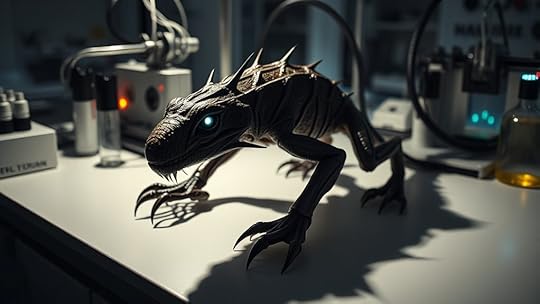
Ethical considerations and potential risks surrounding bio-printed chupacabras demand careful scrutiny, especially as this technology pushes the boundaries of science and morality. You must consider animal rights, as creating such creatures raises questions about their welfare and the morality of manufacturing life for novelty or profit. Ecological risks are also significant; introducing bio-printed chupacabras into natural environments could disrupt existing ecosystems, threaten native species, or cause unpredictable consequences. Additionally, there’s the concern of misuse or accidental release, which could lead to unforeseen ecological damage. As you explore this emerging technology, it’s crucial to balance scientific curiosity with responsible stewardship, ensuring that ethical standards are upheld and risks minimized before moving toward practical applications.
Scientific Challenges in Bio-Printing Complex Organisms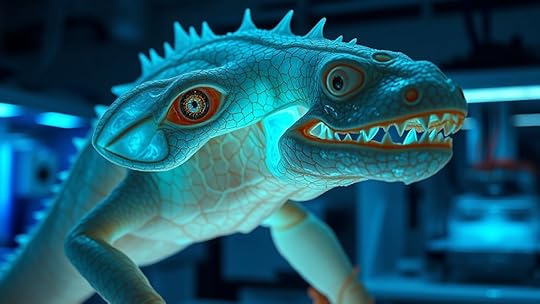
Bio-printing complex organisms like chupacabras presents a host of scientific hurdles that go beyond ethical debates. First, creating effective tissue scaffolding is essential to support cell growth and organization. Without robust scaffolds, tissues lack structure and functionality. Second, vascular integration remains a major challenge; you need to develop viable blood vessel networks to ensure nutrient delivery and waste removal. Third, replicating the organism’s intricate anatomy requires precise layering and spatial control, pushing current bio-printing limits. Finally, maintaining cell viability throughout the process is critical, especially when dealing with diverse cell types and complex tissues. Overcoming these hurdles demands breakthroughs in biomaterials, bioreactor technologies, and precise printing techniques—key steps toward turning bio-printing from science fiction into reality.
The Role of Synthetic Biology in Future Innovations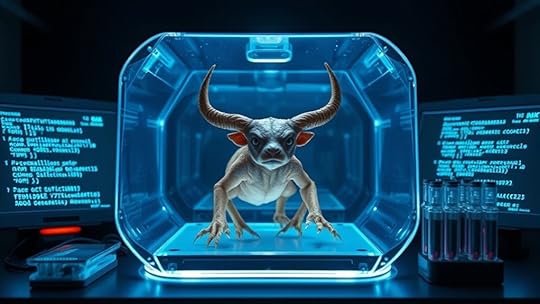
Synthetic biology stands at the forefront of transforming future innovations by enabling precise manipulation of genetic and cellular functions. You can now engineer organisms with tailored traits, opening doors to breakthroughs like lab-grown organs or bio-printed creatures. However, these advances raise significant questions about genetic ethics, especially when creating organisms with human-like features or complex behaviors. Synthetic art emerges as a new frontier, blending biology and creativity to produce living sculptures or bio-designs. As you explore these possibilities, remember that responsible innovation relies on balancing scientific progress with ethical considerations. Synthetic biology’s potential extends beyond medicine and art—it could redefine the very boundaries of life and what it means to create. Your role is pivotal in shaping a future where innovation and ethics coexist.
Public Perception and Cultural Impact of Bio-Printed Creatures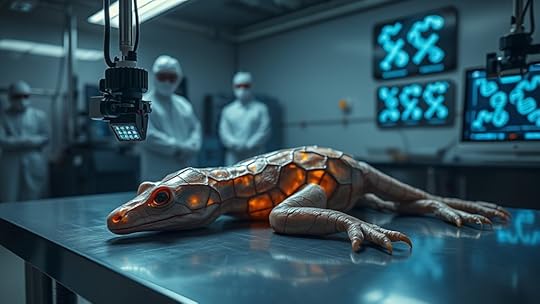
Have you ever wondered how society reacts to the idea of bio-printed creatures like chupacabras? Public skepticism runs high, fueled by fears of unintended consequences and ethical dilemmas. Cultural symbolism plays a significant role, as chupacabras often represent fears of the unknown and threats to tradition. Here are four ways public perception shapes this debate:
Fear of Unnatural Creation – Many see bio-printed creatures as crossing ethical boundaries.Media Influence – Sensational stories amplify skepticism and misunderstanding.Cultural Symbolism – Chupacabras evoke deep-rooted fears and folklore, complicating acceptance.Potential for Misuse – Concerns about bio-printing technology being weaponized or misused persist.Understanding these perceptions is vital for steering the cultural impact of bio-printed creatures in society.
Future Perspectives: From Fictional Creatures to Scientific Breakthroughs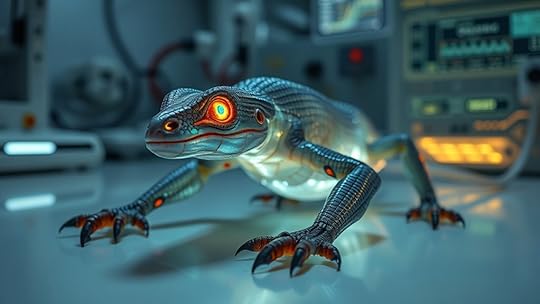
Although the idea of creating creatures like chupacabras once belonged solely to folklore and science fiction, advances in bio-printing are now turning these fantasies into near-future realities. This shift fuels mythic creativity, blurring the lines between imagination and scientific possibility. As researchers explore the limits of bio-printing, ethical debates intensify about the implications of bringing mythical creatures to life. You must consider the moral responsibilities involved in manipulating living tissues to craft beings once confined to legends. Future breakthroughs could lead to extraordinary scientific achievements, but they also challenge societal norms and ethical boundaries. Balancing innovation with responsibility becomes pivotal as we shift from fictional concepts to tangible, bio-printed realities that could revolutionize medicine, conservation, and our understanding of life itself.
Frequently Asked QuestionsCould Bio-Printed Chupacabras Survive Outside Laboratory Conditions?You wonder if bio-printed chupacabras could survive outside lab conditions. While advances might make it possible, ethical considerations and technological limitations pose challenges. You need to contemplate whether it’s responsible to create such organisms and if current tech can sustain them in natural environments. Until these issues are addressed, it’s unlikely that bio-printed chupacabras will thrive outside controlled settings.
How Long Would It Take to Bio-Print a Complete Creature?You might wonder how long it takes to bio-print a complete creature. It depends on technological challenges like developing precise bioprinters and suitable bio-inks, which can take months or years. Ethical considerations also influence the timeline, as researchers must guarantee safety and morality. While progress is rapid, creating a fully functioning organism remains complex, and it could still take significant time before bio-printing a complete creature becomes feasible.
Are There Legal Regulations Governing the Creation of Bio-Printed Mythical Animals?You might wonder if legal regulations cover bio-printed mythical animals. Currently, ethical considerations and intellectual property laws are still catching up with this emerging technology. While some countries have guidelines for genetic modification, specific laws for creating mythical creatures are limited or nonexistent. You should stay informed about evolving regulations, as they’ll shape responsible practices and protect both creators and the broader public from potential risks.
What Are the Potential Ecological Impacts of Releasing Bio-Printed Creatures?You should consider that releasing bio-printed creatures could disrupt ecological balance. These new animals might become invasive species, outcompeting native species for resources and leading to unforeseen environmental consequences. Such releases could threaten biodiversity and destabilize ecosystems. It’s essential to carefully evaluate potential impacts before introducing bio-printed creatures into the wild, as their ecological effects could be profound and difficult to reverse.
Can Bio-Printing Replicate the Behaviors and Instincts of Real Animals?You wonder if bio-printing can replicate animal behaviors and instincts. While genetic mimicry can imitate physical traits, replicating complex instincts is more challenging. You’d need to program neural pathways or use advanced AI to mimic instinctual responses. Though some progress exists, true behavior replication remains difficult. So, you might see some superficial mimicry, but fully capturing animal instincts with bio-printing isn’t quite within reach yet.
ConclusionAs you consider the leap from myth to molecule, remember that the line between science fiction and reality blurs with each breakthrough. Will bio-printed chupacabras become our next scientific marvel or monstrous myth? The choice lies in our hands, shaping a future where imagination fuels innovation. As the horizon of bioengineering expands, you hold the power to decide whether these creatures are mere legends or groundbreaking realities waiting to be born.
July 31, 2025
Space Kraken: Assessing Large‑Life Potential in Europa’s Ocean
Europa’s subsurface ocean likely hosts large, Earth-like organisms supported by chemical energy from hydrothermal vents and nutrient-rich environments. Surface signs, magnetic fields, and spectroscopic data suggest a vast salty, dynamic water reservoir, while advanced detection techniques can identify large biological structures and bioluminescent activity. Exploring these hidden ecosystems is challenging but essential for understanding potential life forms. To uncover more about the space kraken and its environment, keep exploring these intriguing possibilities.
Key TakeawaysSurface mineralogy and surface cracks indicate ongoing water-ice interactions and potential periodic access to Europa’s subsurface ocean.Magnetic and spectroscopic data suggest a salty, conductive ocean layer capable of supporting large, energy-dependent organisms.Detection techniques like bioluminescence monitoring and biosignature analysis aim to identify large biological structures beneath the ice.Challenges include penetrating thick ice layers and distinguishing biological signals from abiotic features with advanced robotic exploration tools.Habitat modeling and biomass estimation prioritize exploration zones with higher likelihood of supporting large life forms, guiding future mission strategies.The Evidence for a Subsurface Ocean on Europa
Scientists have gathered strong evidence suggesting that Europa harbors a subsurface ocean beneath its icy crust. Observations of surface mineralogy reveal salt-rich compounds and hydrated salts, indicating interactions with liquid water below. Photochemical reactions driven by radiation from Jupiter alter surface materials, producing distinctive mineral signatures that imply a dynamic exchange between the surface and an underground ocean. Cracks and ridges observed on Europa’s surface suggest that liquid water may periodically reach the surface, further supporting the presence of a hidden ocean. Magnetic field measurements also point to a conductive, salty layer beneath the ice. All these clues, combined with spectroscopic data, strongly suggest a vast, liquid water reservoir hidden beneath Europa’s icy exterior, making it a prime candidate for hosting potentially habitable environments.
Conditions Favoring Large-Scale Organisms in Europa’s Depths
Deep beneath Europa’s icy crust, conditions may be just right to support large-scale organisms if the subsurface ocean maintains a stable, nutrient-rich environment. Crucial factors include abundant energy sources like methane seepage and chemical gradients, which can fuel life. Stable conditions foster the development of complex ecosystems, possibly allowing organisms to grow large. The presence of methane provides a reliable energy source, supporting chemosynthesis instead of sunlight. These key factors create a potential habitat for sizeable lifeforms, thriving in the ocean’s depths.
ConditionImpactMethane seepageSupplies energy, enabling chemosynthesisStable environmentSupports growth of large organismsNutrient availabilityEnsures sustained biological activityChemical gradientsDrive metabolic processesTechniques for Detecting Enormous Alien Lifeforms
Detecting enormous alien lifeforms beneath Europa’s icy crust requires specialized techniques that can probe the ocean’s depths without direct contact. Remote sensing methods, like radar and sonar, help identify large structures or unusual biophysical signatures indicative of massive organisms. Monitoring for deep sea bioluminescence is essential, as it reveals biological activity in dark waters—bright flashes or glows suggest large, active lifeforms. Additionally, detecting extraterrestrial agriculture, such as submerged farms or nutrient-rich patches, can point to large-scale biological communities. Instruments aboard ice-penetrating submarines or orbital sensors analyze chemical signatures and thermal anomalies linked to biological processes. These techniques, combined, increase your chances of recognizing the presence of space krakens or other colossal organisms lurking beneath Europa’s icy surface.
Challenges in Exploring Europa’s Hidden Ecosystem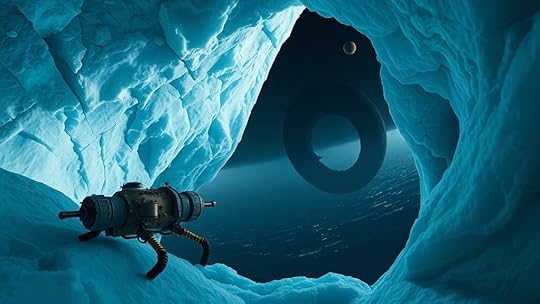
Exploring Europa’s hidden ecosystem presents significant challenges, especially when it comes to maneuvering thick subsurface ice layers. You’ll need to develop methods to detect subtle biological signatures beneath the ice, which can be difficult to distinguish from non-biological signals. Overcoming these hurdles is vital to uncovering the potential for life hidden beneath Europa’s icy crust.
Navigating Subsurface Ice LayersAlthough scientists are eager to uncover Europa’s hidden ecosystem, traversing its thick subsurface ice layers presents significant challenges. The subsurface ice is dense and difficult to penetrate, requiring advanced drilling technologies or cryobots capable of melting through kilometers of ice. You must also consider ocean dynamics beneath the ice, which can affect the stability and integrity of exploration equipment. Cracks and fissures in the ice can cause unpredictable shifts, complicating navigation and increasing the risk of equipment failure. Temperature fluctuations and pressure variations add further complexity, demanding resilient systems designed to withstand extreme conditions. Overcoming these hurdles is essential for reaching Europa’s ocean, but doing so will deepen our understanding of its potential for supporting large-life forms.
Detecting Biological SignaturesHow can scientists identify signs of life beneath Europa’s thick ice, given the extreme conditions and limited access? Detecting biological signatures requires innovative methods. You might look for chemical clues like organic molecules or isotopic ratios indicating marine symbiosis, where organisms depend on each other and transfer energy efficiently. Remote sensing tools, such as spectrometers, can analyze plumes or ice meltwater for these signatures. Submersibles or ice-penetrating radars could directly sample the ocean, seeking microbial life or biofilms. Key indicators include:
Organic molecules linked to marine symbiosisChemical gradients suggestive of energy transferMicrobial or biofilm structuresEnzymatic or genetic material in water samplesThese approaches aim to uncover subtle signs of life, charting the challenge of exploring Europa’s hidden ecosystem with precision.
Signatures and Indicators of Large Biological Presence
Detecting large biological presence in Europa’s ocean hinges on identifying specific signatures and indicators that suggest active, sizable life forms. Look for biosignature complexity, such as diverse organic molecules or structures, which indicate ongoing biological processes. Energy availability drives these processes and influences observable signs. To visualize potential indicators, consider this table:
Biosignature ComplexityEnergy AvailabilityObservable IndicatorsDiverse organic moleculesHydrothermal ventsLarge biomasses or coloniesUnique mineral depositsChemical gradientsSurface debris or biomatterStructural biological featuresRedox gradientsConcentrated organic signaturesThese signatures point to a thriving ecosystem, where energy fuels large life forms and biosignature complexity reflects active biological systems.
Implications for Astrobiology and Future Missions
Considering the potential for life in Europa’s ocean, you need to focus on effective detection strategies and how they influence mission designs. These approaches determine the tools and methods you’ll use to identify biosignatures and biological activity. By understanding these implications, you can better plan future missions to maximize their chances of success.
Life Detection StrategiesExploring life in Europa’s subsurface ocean requires innovative detection strategies that can operate in extreme and inaccessible environments. You need methods capable of identifying biological activity amid high pressure, low temperatures, and darkness. Detecting thermal vents can reveal localized heat, indicating potential habitats. Analyzing chemical signatures—such as organic molecules or bioessential elements—helps confirm biological processes. You might deploy robotic probes that analyze ocean samples directly or use spectrometers to detect signatures from afar. Environmental DNA (eDNA) sampling could identify living organisms indirectly. Additionally, sensors designed for extreme conditions can monitor temperature fluctuations and chemical changes over time.
Thermal vent detection for heat anomaliesChemical signature analysis for organicsIn situ robotic samplingRemote sensing of biological markersMission Design ConsiderationsHow can future mission designs maximize their potential to discover life beneath Europa’s icy shell? Focusing on biomass estimation helps determine the likely abundance of organisms, guiding sampling priorities. Incorporating habitat modeling allows you to predict where life-supporting environments may exist, such as hydrothermal vents or nutrient-rich ice layers. Instruments should be tailored to detect biosignatures and quantify organic material efficiently. Drilling or melting technologies must access diverse habitats while minimizing contamination. Combining these strategies ensures you target the most promising areas, increasing the chances of detecting large life forms. Flexibility in mission architecture enables adapting to new data, refining habitat models, and focusing exploration efforts where biomass estimations indicate the highest potential for life.
Frequently Asked QuestionsHow Could Large Organisms Survive in Europa’s Extreme Environment?You wonder how large organisms might survive in Europa’s extreme environment. In deep sea ecosystems on Earth, extremophile adaptations help organisms withstand high pressure, cold temperatures, and lack of sunlight. If similar adaptations occur in Europa’s ocean, large life forms could survive by evolving pressure-resistant bodies, chemosynthesis-based energy sources, and specialized biochemical processes. These extremophile traits enable life to thrive even in the planet’s harsh, alien conditions.
What Specific Technologies Are Most Promising for Detecting Large Lifeforms?Oh, sure, because what’s more thrilling than hunting for space whales? You’ll want to rely on biomarker sensors to detect signs of life and deep sea imaging to visualize those elusive giants. These tech marvels can sift through Europa’s icy depths, catching bio-signatures and massive forms lurking beneath the ice. With such tools, you’re practically a cosmic marine biologist on the hunt for extraterrestrial leviathans.
Could Europa’s Ocean Support Complex Multicellular Life?You wonder if Europa’s ocean can support complex multicellular life, considering subsurface biospheres and evolutionary constraints. The ocean’s potential depends on energy sources and chemical nutrients, which could foster diverse ecosystems. If these subsurface biospheres provide stable conditions and sufficient resources, complex multicellular life might evolve. However, the evolutionary constraints of such an environment could limit the development of highly complex organisms, making the possibility uncertain but intriguing.
What Are the Risks of Contaminating Europa During Exploration?During exploration, you face significant risks of contaminating Europa, which can threaten its pristine environment. To protect potential extraterrestrial life, planetary protection protocols are essential. You must implement contamination mitigation measures to prevent Earth microbes from hitchhiking on spacecraft. By adhering to strict sterilization standards, you help preserve Europa’s natural state, ensuring scientific integrity and minimizing the risk of cross-contamination that could jeopardize future research and the moon’s unique ecosystem.
How Would Discovering Large Lifeforms Impact Our Understanding of Life’s Origins?Imagine uncovering colossal creatures in Europa’s icy depths; this discovery would dramatically deepen your understanding of life’s origins. It would challenge current views, expanding astrobiology implications and revealing unexpected evolutionary pathways. Finding large lifeforms suggests life can thrive in extreme environments, broadening the scope of extraterrestrial possibilities. You’d see that life’s potential extends beyond Earth, prompting profound questions about the diversity and resilience of life across the universe.
ConclusionSo, you’re telling me there’s a giant space kraken lurking beneath Europa’s icy shell? Well, buckle up, because if we actually find massive alien creatures, we’ll have to rewrite biology books—and maybe our entire understanding of life. Who knew that beneath all that ice, an underwater monster movie was playing out? Keep dreaming big, because someday, you might just get to shake hands with the universe’s most elusive, tentacled wonder.
July 30, 2025
Monster Metaverse: How VR Might Archive Cryptid Encounters
In the monster metaverse, VR can help you archive cryptid encounters through immersive digital environments that recreate sightings and habitats. Advanced rendering and sensory techniques make virtual creatures feel real, allowing you to explore and document mythical animals naturally. Communities can share stories, participate in investigations, and preserve endangered folklore digitally. As technology evolves, these virtual archives will grow more detailed and interactive, offering you a deeper understanding of cryptids and their cultural ties. Keep exploring to uncover how this future unfolds.
Key TakeawaysVR enables immersive, interactive archives of cryptid sightings, preserving detailed experiences and environmental contexts for future research.Digital simulations and virtual habitats facilitate pattern analysis and habitat mapping of cryptid encounters globally.Sensory immersion techniques, including haptic feedback and environmental cues, enhance the realism of recorded encounters.Virtual platforms support community-driven investigations, live events, and storytelling, fostering collective engagement and preservation.VR helps safeguard intangible cultural heritage by digitally reconstructing legends, rituals, and local folklore associated with cryptids.The Evolution of Cryptid Documentation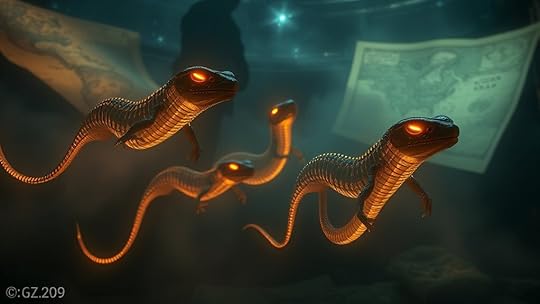
The way we document cryptids has transformed dramatically over time, moving from folklore and anecdotal reports to systematic scientific investigations. Early on, folklore analysis played a key role, as stories and legends shaped perceptions of these creatures. As interest grew, researchers began applying cryptid taxonomy to categorize and evaluate sightings more objectively. This shift allowed us to move beyond myths, analyzing evidence with scientific rigor, such as footprint casts or photographs. Today, digital tools and databases help organize reports and facilitate cross-referencing, making it easier to identify patterns or debunk false claims. This evolution reflects a broader effort to understand cryptids not just as legends but as phenomena worthy of scientific inquiry, paving the way for more credible and structured research.
Immersive Encounters: Bringing Mythical Creatures to Life
You can experience mythical creatures as if they’re truly alive through increasingly realistic virtual representations. Sensory immersion techniques, like haptic feedback and spatial audio, heighten the sense of presence. Interactive encounters let you engage directly with these beings, making the myth feel astonishingly real.
Virtual Creature RealismHarnessing advanced rendering technologies, developers craft virtual creatures that respond convincingly to their environment, making mythical beings feel astonishingly real. They utilize creature behavior modeling to ensure these entities act naturally, reacting dynamically to your movements and surroundings. Bioluminescent displays add an extra layer of realism; glowing patterns on scales or fur illuminate their presence, especially in dark virtual settings. These visual cues mimic natural animal signals, enhancing immersion and believability. Developers constantly refine animations and physics to ensure creatures exhibit lifelike movements, from graceful sways to sudden reactions. This combination of detailed behavior modeling and stunning visual effects makes encounters feel authentic, drawing you deeper into the mythic worlds where these creatures truly seem alive and responsive.
Sensory Immersion TechniquesBy engaging multiple senses simultaneously, developers create truly immersive encounters with mythical creatures that feel almost tangible. Haptic feedback plays a vital role, allowing you to feel the texture of scales, fur, or skin as you approach or touch these beings. Multisensory cues, such as ambient sounds, subtle scents, and visual effects, further deepen the experience, making each encounter more realistic. For example, the rumble of footsteps or the warmth of a creature’s breath can heighten your sense of presence. These sensory immersion techniques work together to break down the barrier between virtual and physical worlds, creating a vivid, convincing experience. As a result, you don’t just observe mythical creatures—you truly feel like you’re part of their environment.
Interactive Mythical EncountersBuilding on the immersive techniques that make mythical creatures feel tangible, interactive encounters take the experience a step further by allowing you to engage directly with these beings. In virtual monster museums, you can walk alongside cryptids like the Loch Ness Monster or Chupacabra, observing their movements and behaviors up close. Some platforms even enable you to try cryptid cosplay, dressing up as these creatures for a fully immersive role-playing experience. You might converse with the cryptids, explore their habitats, or participate in quests that deepen your connection. These interactive features make encounters more personal and memorable, transforming static displays into dynamic adventures. By actively engaging with these mythical beings, you help preserve cryptids’ stories while experiencing a new level of digital realism.
Virtual Reality as a Tool for Cryptid Research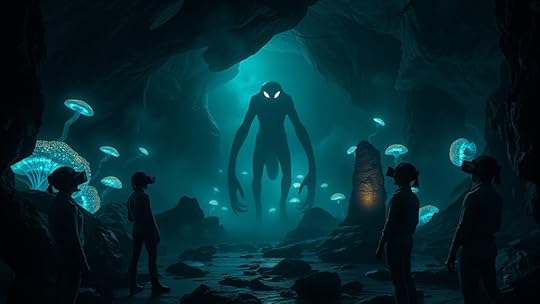
Virtual reality has emerged as a powerful tool for cryptid research, allowing investigators to immerse themselves in environments where sightings or evidence have been reported. With VR, you can refine hunting strategies by virtually exploring vast terrains, identifying likely cryptid habitats, and testing different approaches without leaving your location. Cryptid habitat mapping becomes more precise as you analyze terrain features, water sources, and vegetation patterns in a controlled, simulated setting. This immersive technology helps you understand how cryptids might move and hide, increasing your chances of locating evidence. By combining real-world data with virtual explorations, you improve your investigative accuracy. VR transforms cryptid research into a more strategic, data-driven effort, making the hunt for elusive creatures more systematic and promising.
Building Digital Archives of Cryptid Sightings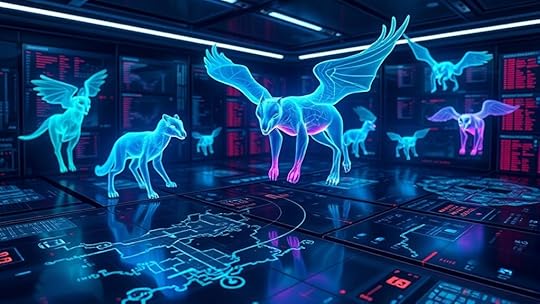
You can create digital witness records to document cryptid sightings accurately and efficiently. Using VR archiving techniques helps preserve these observations in immersive, accessible formats. By implementing these methods, you guarantee cryptid data remains safe, organized, and ready for analysis or public sharing.
Digital Witness RecordsHave you ever wondered how digital archives of cryptid sightings are created and maintained? You become a digital witness by submitting your encounters through secure platforms that utilize biometric tracking to verify your identity and authenticity. These records are stored in databases accessible via holographic displays, allowing researchers and enthusiasts to explore sightings in immersive 3D environments. Biometric data helps authenticate reports, reducing false entries and ensuring credibility. When you upload a sighting, your device captures essential signs and location details, which are then integrated into the archive. This combination of biometric tracking and holographic technology creates a vivid, interactive record of cryptid encounters, making it easier to analyze patterns and verify sightings. Your contribution becomes part of a growing digital repository shaping cryptid research.
VR Archiving TechniquesBuilding on the foundation of digital witness records, VR archiving techniques revolutionize how cryptid sightings are preserved and explored. You can create immersive archives by integrating AR overlays that enhance visual details, providing context and depth to sightings. Biometric feedback captures your physiological responses during reconstructions, offering insights into emotional reactions and engagement levels. These sensors track heart rate, skin conductance, and other metrics, helping archivists refine presentation methods. By combining AR overlays with biometric data, you’re able to develop dynamic, multi-layered archives that feel authentic and interactive. This approach guarantees that future researchers and enthusiasts access rich, detailed, and emotionally resonant records of cryptid encounters, bridging the gap between virtual exploration and genuine experience.
Preserving Cryptid DataPreserving cryptid data is essential for creating reliable and accessible digital archives that document sightings accurately. You need a systematic approach to cryptid taxonomy, categorizing creatures based on physical features, behaviors, and geographic locations. This helps guarantee consistency across reports and enables effective folklore analysis, revealing patterns and cultural significance behind sightings. Digital archives should incorporate multimedia evidence like photos, videos, and audio recordings, all securely stored with metadata for easy retrieval. You also want to implement version control and data validation to maintain integrity over time. By doing so, you create a thorough resource that supports research, myth analysis, and public engagement, preserving cryptid encounters for future generations while fostering a deeper understanding of folklore and cryptozoology.
Enhancing Public Engagement With Cryptozoology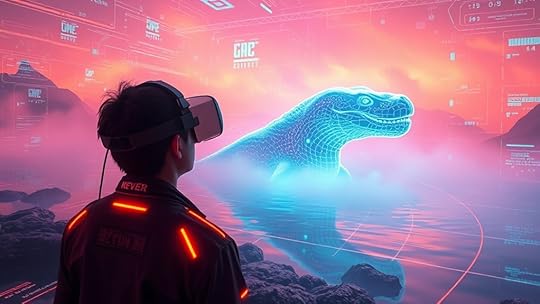
How can the Monster Metaverse make cryptozoology more engaging for the public? By integrating AI companionship and immersive virtual reality gaming, you can explore cryptids firsthand. These tools foster curiosity and interaction, making encounters feel real. Imagine chatting with an AI guide or tracking elusive creatures in a virtual wilderness. To visualize this, consider the table below:
FeatureBenefitAI CompanionshipPersonalized cryptid encounters and learningVirtual Reality GamingImmersive exploration of cryptid habitatsCommunity ChallengesCollective investigations and shared discoveriesInteractive QuizzesEngaging educational contentLive EventsReal-time cryptid sightings and updatesThis approach sparks public interest, encourages participation, and deepens understanding of cryptozoology.
Challenges and Limitations of VR Cryptid Experiences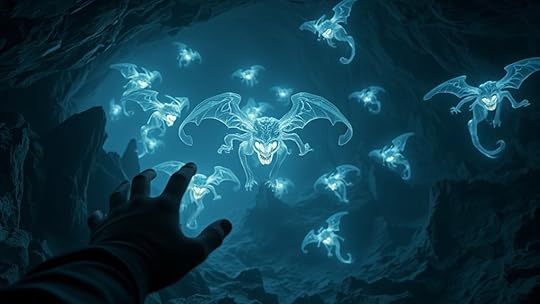
As you explore VR cryptid experiences, you’ll notice technological constraints that can break immersion and make encounters less convincing. Ethical concerns also arise over the authenticity of these virtual sightings, raising questions about their impact on real-world beliefs. Additionally, accessibility and costs can limit who gets to participate, preventing wider engagement.
Technological Constraints Limit ImmersionDespite rapid advances in virtual reality technology, several key limitations still hinder fully immersive cryptid experiences. You might notice that haptic feedback isn’t always convincing, leaving sensations feeling flat or disconnected. Resolution constraints can make visuals appear blurry or pixelated, breaking your sense of presence. Additionally, current VR headsets often struggle with latency, causing delays that disrupt immersion. Finally, the limited field of view restricts peripheral vision, making encounters feel less real. To summarize:
Haptic feedback often lacks realism, reducing tactile immersion.Resolution constraints create pixelation, diminishing visual fidelity.Latency issues cause motion sickness or disorientation.Narrow fields of view limit peripheral awareness during encounters.These tech constraints make it challenging to fully believe in cryptid sightings within virtual worlds.
Ethical Concerns Over AuthenticityThe rise of VR cryptid experiences raises significant ethical questions about authenticity and deception. You might wonder if these virtual encounters truly represent the creatures or simply fictionalized myths. Authenticity concerns come into play, as users could be misled into believing these experiences are factual or based on real sightings. This raises moral questions about honesty and the responsibility of creators to avoid misleading audiences. Additionally, cultural misrepresentation is a real risk; VR experiences might distort or oversimplify the origins and significance of cryptids rooted in specific cultures. Such misrepresentation can perpetuate stereotypes or erase important cultural contexts. Steering through these ethical issues requires transparency and sensitivity to ensure that virtual cryptid encounters respect authenticity and cultural integrity.
Accessibility and Cost BarriersWhile VR cryptid experiences offer exciting new ways to explore mythical creatures, they also face significant accessibility and cost barriers. High-quality VR rigs can be expensive, making it difficult for many to participate. Accessibility challenges include limited hardware compatibility and the need for a powerful computer or console. Additionally, not everyone has a dedicated space for immersive experiences, which can hinder participation. Here are some common obstacles:
Cost barriers for purchasing VR headsets and equipmentLimited access for people with disabilities or physical limitationsIncompatibility with older or less advanced devicesLack of affordable options in underserved communitiesOvercoming these hurdles is vital to making VR cryptid encounters more inclusive and widely available.
Ethical Considerations in Virtual Cryptid Preservation
As virtual cryptid preservation gains popularity, it raises important ethical questions about your responsibilities toward these digital entities. Privacy concerns become relevant as these virtual creatures may contain sensitive data or personal stories, risking misuse if not properly protected. You must consider whether these entities have a form of digital autonomy or rights, and if so, how to respect their integrity. Consent issues are equally critical; creators and users should agree on how cryptids are depicted, shared, or altered. Without clear guidelines, you risk exploiting or misrepresenting these entities, undermining ethical standards. You’re responsible for establishing respectful practices that honor the digital consciousness of cryptids, ensuring their preservation aligns with moral principles rather than mere technological capability.
The Role of Community in Shaping the Monster Metaverse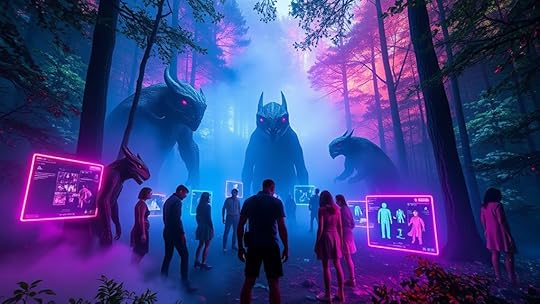
How does community involvement influence the evolution of the Monster Metaverse? Your participation shapes the world through community narratives and collective mythmaking. When you share sightings, stories, or theories, you help build a dynamic, shared mythology that guides the metaverse’s development. Your contributions encourage others to add their perspectives, creating a collaborative environment. Here are four ways your involvement makes an impact:
Fuels storytelling that forms the backbone of the cryptid lore.Shapes virtual habitats based on popular community ideas.Creates shared experiences that enhance immersion.Influences updates and features through collective input.Community input fuels the Monster Metaverse’s growth through shared stories, habitats, experiences, and collective development.
Together, your stories and beliefs forge a vibrant, evolving cryptid universe rooted in collective mythmaking.
Future Innovations in VR and Cryptid Exploration
The future of VR and cryptid exploration promises to revolutionize how you experience and interact with these mysterious entities. Advances like quantum entanglement could enable real-time, immersive connections across vast distances, making encounters feel instant and authentic. Neural interfaces will likely become more sophisticated, allowing you to directly link your brain to virtual environments, enhancing sensory perception and emotional responses. These innovations will facilitate deeper exploration, letting you feel as if you’re truly in the presence of cryptids. As technology progresses, you’ll be able to access highly realistic simulations that adapt to your reactions, blurring the lines between reality and virtuality. Ultimately, these breakthroughs will make cryptid encounters more vivid, personal, and scientifically intriguing than ever before.
Potential Impacts on Cultural Heritage and Folklore
Emerging VR and metaverse technologies have the potential to profoundly reshape cultural heritage and folklore by bringing traditional stories and legends into immersive digital spaces. You can experience folklore dissemination firsthand, making myths more accessible worldwide. This technology enables you to:
Preserve endangered cultural practices through virtual reconstructions.Share folklore with global audiences, fostering cross-cultural understanding.Engage younger generations with interactive storytelling, ensuring cultural preservation.Create collaborative environments where communities can add their own legends and traditions.Frequently Asked QuestionsHow Accurate Are Virtual Cryptid Representations Compared to Real Sightings?You wonder how accurate virtual cryptid representations are compared to real sightings. Digital accuracy depends on the quality of data and technology used, but it can’t fully replicate the nuances of actual encounters. Your perception plays a big role, as immersive VR can enhance realism, yet might also create biases or exaggerations. While virtual depictions aim for authenticity, they often fall short of capturing the true mystery and unpredictability of real cryptid sightings.
Can VR Experiences Influence Public Perceptions of Cryptids?Your VR experiences can profoundly influence public perceptions of cryptids by shaping digital authenticity and cultural impact. When you engage with realistic, immersive VR encounters, you’re more likely to believe in their existence or share these stories, amplifying their cultural significance. These experiences can blur lines between fact and fiction, making cryptids feel more real and impacting how society perceives folklore, legends, and the mysterious creatures that inspire curiosity and fear.
What Are the Privacy Implications of Sharing Cryptid Sightings Digitally?Did you know that 80% of users worry about data privacy when sharing sightings online? When you upload cryptid encounters digitally, you risk exposing personal info, potentially compromising your anonymity. Sharing these stories can lead to data privacy concerns, making it harder to protect your identity. Be cautious and consider how your digital footprint might be used or misused, especially if you value personal anonymity in the cryptid community.
How Do VR Cryptid Encounters Affect Traditional Cryptozoology Research Methods?You might find that VR cryptid encounters influence traditional cryptozoology research by emphasizing digital authenticity, making sightings more convincing. However, it also raises concerns about researcher bias, as virtual experiences could be skewed or manipulated. This shift encourages you to verify evidence carefully and consider how immersive technology impacts credibility. Ultimately, VR offers new tools, but you must remain critical to preserve the integrity of cryptid research.
Will VR Cryptid Archives Become Accessible to the Global Public?You’ll likely see public access to digital archives of VR cryptid encounters grow, making these immersive experiences widely available. As technology advances, these virtual archives could become part of open resources, allowing enthusiasts and researchers worldwide to explore cryptid encounters firsthand. You might soon access a vast library of VR encounters, bridging the gap between enthusiasts and scientific exploration, and preserving cryptid lore for future generations to study and enjoy.
ConclusionImagine stepping into a vast, enchanted forest where every whisper and shadow holds a secret waiting to be uncovered. As you explore the monster metaverse, you become part of a living tapestry, weaving myth and reality together. With each encounter, you help preserve legends that might fade into memory. In this digital wilderness, your curiosity becomes a lantern, guiding future generations through the mysterious, timeless dance of folklore and discovery.
July 29, 2025
The Ethics of Breeding Mini‑Bigfoots in Labs of Tomorrow
Breeding mini-Bigfoots raises important ethical questions about animal welfare, genetic integrity, and moral responsibility. While science could provide insights into growth and genetics, it also risks compromising the creatures’ health and autonomy. Society’s views vary, and strict regulations are essential to guarantee responsible practices. If you explore further, you’ll discover how society, ethics, and regulation intertwine in shaping our future approach to such extraordinary endeavors.
Key TakeawaysEthical concerns center on animal welfare, natural integrity, and potential health risks from breeding mini-Bigfoots.Genetic manipulation raises moral questions about creating sentient beings and respecting their intrinsic rights.Maintaining genetic diversity and natural behaviors is crucial to prevent suffering and ensure well-being.Cultural values influence perceptions of breeding mini-Bigfoots, affecting societal acceptance and moral judgments.Implementing strict regulations and oversight is essential to balance scientific progress with ethical responsibilities.Scientific Justifications and Potential Benefits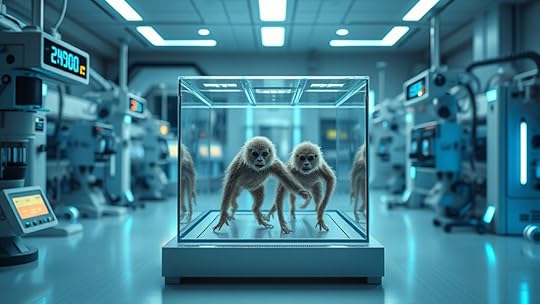
While some argue that breeding mini-Bigfoots offers limited scientific value, proponents believe it can reveal valuable insights into genetics, growth regulation, and developmental biology. Through experimental breeding, you can observe how specific genes influence size and development, providing a controlled way to study growth patterns. Genetic modification plays a key role, allowing you to uncover particular genes associated with size or physical traits. These experiments could improve understanding of gene expression, mutation effects, and developmental pathways. Such research might also inform medical science by shedding light on growth disorders. Although controversial, this scientific approach aims to unlock biological mysteries, offering potential breakthroughs in genetics and developmental biology that could benefit broader scientific and medical fields.
Ethical Concerns and Moral Dilemmas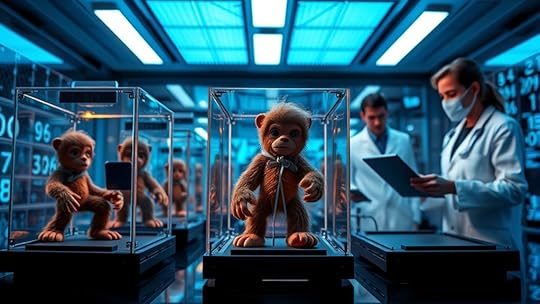
Breeding mini-Bigfoots raises profound ethical concerns that demand careful consideration. One major issue is maintaining genetic purity, which challenges the integrity of natural species and risks unintended consequences. You might wonder if manipulating genetics for size compromises the animal’s identity or leads to unforeseen health problems. Additionally, the practice can foster animal commodification, reducing these creatures to products for research or entertainment rather than living beings with intrinsic value. This commodification raises moral questions about respect for life and the responsibilities that come with creating sentient creatures. You need to weigh the scientific benefits against the moral implications of exploiting animals for human interests, ensuring that ethical boundaries aren’t crossed in pursuit of innovation.
Impact on the Creatures’ Welfare and Rights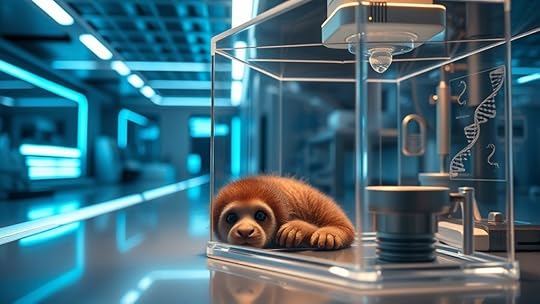
The welfare and rights of mini-Bigfoots are directly impacted by the ethical choices made during their breeding. If genetic diversity is overlooked, these creatures face increased health issues and a loss of resilience. Respecting animal autonomy means acknowledging their needs and natural instincts rather than treating them as mere experiments. Your decisions can either promote well-being or cause suffering, affecting their ability to live freely and naturally. Consider the emotional toll of confinement, restricted movement, and unnatural environments. Here’s how their welfare can be compromised or protected:
Welfare AspectPotential ImpactEthical ConcernGenetic DiversityIncreased health risksLoss of resilience and vitalityNatural BehaviorSuppressed instinctsLoss of autonomy and freedomPhysical Well-beingPoor living conditionsSuffering and distressSocial InteractionIsolation or forced groupingEmotional traumaOverall AutonomyRestricted choicesViolation of innate rightsSocietal Implications and Cultural Perspectives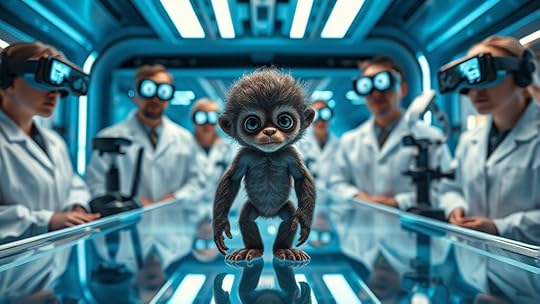
Societal attitudes and cultural values shape how mini-Bigfoots are perceived and treated, influencing the ethical frameworks surrounding their breeding. Your public perception often hinges on cultural symbolism—some see these creatures as symbols of nature’s wonder, while others view them as scientific curiosities. These perceptions affect societal acceptance and ethical debates, shaping policies and social norms. If mini-Bigfoots are seen as sacred or emblematic, it’s more likely society will oppose their exploitation. Conversely, if they’re regarded as mere specimens, ethical concerns may diminish. Your cultural lens determines whether you view their creation as a moral triumph or a violation. Understanding these perspectives helps you grasp the complex societal implications of breeding mini-Bigfoots and how cultural symbolism influences collective attitudes.
Regulatory Frameworks and Future Oversight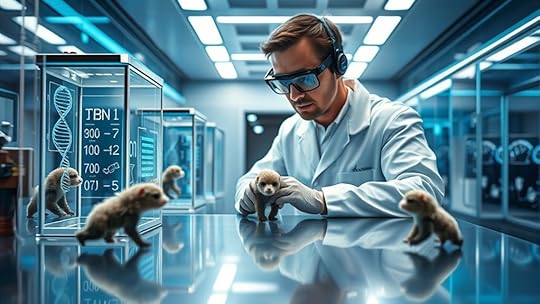
As the ethical and societal debates surrounding mini-Bigfoot breeding intensify, establishing robust regulatory frameworks becomes essential to guarantee responsible practices. You need clear guidelines for genetic modification procedures to prevent unintended consequences and ensure animal welfare. Effective regulatory oversight will help monitor research activities, enforce ethical standards, and hold breeders accountable. Future oversight should include independent review boards and transparent reporting to maintain public trust. You must also consider international cooperation, as genetic modification and mini-Bigfoot breeding can have cross-border implications. By creating detailed regulations, you can foster responsible innovation while minimizing risks. Ultimately, these frameworks serve to balance scientific progress with ethical responsibility, ensuring that the pursuit of knowledge doesn’t compromise societal values or animal welfare.
Frequently Asked QuestionsWhat Are the Long-Term Genetic Impacts of Breeding Mini-Bigfoots?You might worry that breeding mini-bigfoots could reduce genetic diversity, making the population more vulnerable to diseases or environmental changes. Additionally, you could see increased mutation rates over time, leading to unpredictable traits or health issues. These long-term genetic impacts might threaten their survival and stability, emphasizing the importance of careful breeding practices to maintain genetic health and minimize risks associated with limited gene pools.
Could Mini-Bigfoots Develop Unique Psychological Traits or Disorders?Imagine mini-bigfoots as tiny explorers in a vast forest, each with unique paths. You might wonder if they develop psychological traits or disorders, like behavioral abnormalities that stem from their environment. These creatures could face struggles affecting their psychological resilience, shaping how they respond to stress or social bonds. As their tiny worlds differ, their mental health could mirror the complexity of larger beings, raising questions about their emotional well-being.
How Do Breeders Ensure Transparency and Public Accountability?You guarantee transparency and public accountability by implementing strict ethical oversight, making all breeding practices and research publicly accessible. Regularly sharing updates and findings builds trust, showing you prioritize responsible science. Engaging with independent review boards and community stakeholders guarantees accountability, demonstrating your commitment to ethical standards. This openness helps maintain public trust, reassuring people that the well-being of mini-bigfoots and societal interests are always at the forefront of your work.
Are There Any Potential Ecological Risks Associated With Mini-Bigfoots?Did you know that introducing mini-bigfoots could threaten local ecosystems? You might not realize it, but they pose ecological risks like habitat disruption and becoming invasive species. If these creatures escape or are released, they could outcompete native species, altering food chains and damaging habitats. It’s vital to take into account these risks before breeding mini-bigfoots, as unintended ecological consequences could be severe and long-lasting.
What Cultural or Spiritual Beliefs Influence Perceptions of Mini-Bigfoots?You might find that cultural and spiritual beliefs shape how people see mini-bigfoots. Mythical symbolism often links them to legendary creatures, sparking wonder or fear. Some hold spiritual reverence, believing mini-bigfoots possess special powers or serve as guardians. These perceptions influence public attitudes, making discussions about their existence deeply rooted in tradition and belief systems. Your perspective may shift based on whether you view them as myth, spiritual beings, or biological entities.
ConclusionAs you imagine a future where labs nurture tiny Bigfoots, consider the delicate balance of wonder and responsibility. Picture these small creatures, eyes glinting with curiosity, yet confined behind glass, their wild essence tamed. It’s up to you to decide if science’s pursuit of knowledge justifies the moral costs. Will you champion innovation that respects their rights, or let curiosity overshadow compassion in this unfolding story of ethical discovery?
July 27, 2025
Could Time‑Travel Technology Verify Urban Legends?
Time-travel technology could potentially verify urban legends by allowing you to observe past events directly. However, current scientific and technical challenges, like energy needs, timeline stability, and ethical concerns, make this difficult to achieve now. While the idea remains intriguing, significant hurdles need addressing before it’s practical. If you explore further, you’ll discover what advancements and risks might shape the future of confirming legendary stories.
Key TakeawaysTime travel could allow direct observation of historical events behind legends, enabling verification or debunking.Advanced sensors and quantum entanglement may facilitate detailed environmental recordings from the past.Cross-referencing past event data with existing historical records can help confirm legends’ authenticity.Technical challenges like energy requirements, temporal stability, and causality risks limit current verification capabilities.Ethical and paradox concerns complicate interventions, potentially affecting the accuracy and safety of legend verification.The Science Behind Time-Travel Possibilities
While time travel remains a popular topic in science fiction, scientists have explored several real theories that suggest it might be possible someday. One key idea involves quantum entanglement, where particles become interconnected regardless of distance, hinting at faster-than-light communication. Some theorists propose that manipulating entangled particles could enable information transfer across different times, though not yet actual time travel. However, these concepts raise concerns about temporal paradoxes—situations where cause and effect clash, like the famous grandfather paradox. While these paradoxes highlight potential logical issues with backward time travel, ongoing research in quantum physics continues to push the boundaries of what might be achievable. Although speculative, these theories provide a scientific foundation for understanding how time travel could one day become a reality.
Historical Evidence and the Challenge of Verification
Historical evidence for time travel remains elusive, and verifying such claims is inherently challenging. In paranormal research, the lack of concrete, reproducible data makes it difficult to confirm extraordinary stories. Many urban legends and folklore are passed down through generations, complicating efforts to distinguish fact from fiction. When analyzing folklore, you must consider cultural context and the tendency for stories to evolve over time. Without verifiable physical evidence, it’s nearly impossible to prove that time travel played a role in these legends. Skeptics argue that most accounts are anecdotal, making validation impossible. To move forward, you need rigorous methods and critical analysis, but the elusive nature of historical evidence keeps in the domain of speculation rather than verified history.
Famous Urban Legends That Could Be Investigated
You might wonder if some urban legends are based on real events or sightings. Could historical accounts of strange creatures or unexplained appearances hold truths waiting to be uncovered? Exploring these stories might reveal surprising connections to our understanding of history and possible time-travel evidence.
Historical Sightings RevisitedMany urban legends hinge on supposed sightings of mysterious figures or unexplained phenomena that defy logical explanation. These stories often involve strange encounters with mythical artifacts or glimpses of figures from folklore preservation efforts. With time-travel technology, you could revisit these moments, verifying their truth or uncovering new details. Investigating these sightings might reveal hidden histories or confirm long-held suspicions.
Consider these intriguing possibilities:
Re-examining a ghostly figure linked to a famous historical eventTracking down a mysterious artifact reported in a legendary encounterClarifying the origins of a strange light seen during a purported sightingCross-referencing eyewitness accounts with historical recordsUncovering whether these legends are rooted in real events or folklore preservation effortsMythical Creatures Confirmed?Could some of the legendary mythical creatures actually be real? With recent advances in technology, cryptid sightings might be more credible than you think. Time-travel could enable investigators to verify folklore origins that have long fueled urban legends. For example, creatures like the Loch Ness Monster or Bigfoot have been subjects of countless reports, yet remain unconfirmed by science. But if you could witness past cryptid sightings firsthand, you might uncover clues that support their existence. The idea that these legends stem from misunderstood encounters or misidentified animals is challenged by the possibility of verifying sightings across different eras. With time-travel, you could finally determine whether these mythical creatures are just folklore or hidden realities waiting to be uncovered.
Potential Methods for Using Time Travel to Confirm Stories
One promising way to verify urban legends with time travel involves pinpointing specific moments in history when the stories are said to have originated. By traveling to these precise points, you could observe firsthand whether the legends are based on real events or myths. To avoid confusion with parallel universes or alternate timelines, you’d focus on the original context, ensuring accurate comparison.
Use advanced sensors to record environmental details from the pastCross-reference historical records with your observationsTravel to multiple points to verify consistency in the storyIsolate yourself to prevent influencing eventsConsider the possibility of alternate timelines creating different versions of the legendTravel to key moments in history to verify if urban legends are based on real events or myths.
This approach helps you confirm if legends are rooted in actual events or just cultural fabrications.
Ethical Considerations and Risks in Temporal Exploration
As you explore time travel, you must consider significant ethical risks like paradoxes and causality disruptions that could alter history unexpectedly. Privacy concerns also arise when accessing past events involving individuals who never consented to be observed. Additionally, even minor changes might unintentionally impact the course of history, raising questions about your responsibility to preserve the timeline.
Paradoxes and Causality RisksTime-travel technology introduces profound ethical challenges rooted in paradoxes and causality risks. You might create causal loops where actions in the past influence the present unexpectedly, leading to unintended consequences. Paradox resolution becomes vital to prevent scenarios like the “grandfather paradox,” where altering history could erase your existence. These risks challenge our understanding of cause and effect, raising questions about responsibility and safety.
Charting causal loops without causing irreversible damageEnsuring paradox resolution to avoid logical inconsistenciesPreventing unintended alterations to the timelineAddressing moral dilemmas of changing past eventsBalancing curiosity with the potential for catastrophic consequencesTemporal Privacy ConcernsWhile the prospect of exploring different moments in history offers incredible opportunities, it also raises serious ethical concerns about privacy. Accessing past events could expose sensitive personal data, leading to critical data privacy issues. You might unintentionally observe private moments or confidential information, risking harm or misuse. Surveillance concerns intensify if time-travel technology is exploited for monitoring individuals without consent. Such unchecked access could create a chilling effect, eroding trust and infringing on personal freedoms. Protecting privacy requires strict guidelines on what historical data can be accessed and how it’s used. Without safeguards, the temptation to invade personal spaces or exploit sensitive information increases, posing significant ethical dilemmas in temporal exploration. Balancing discovery and privacy becomes essential to avoid serious moral violations.
Unintended Historical ImpactExploring the past with time-travel technology can unintentionally alter historical events, leading to unforeseen consequences that ripple through time. Small changes might seem harmless but can trigger complex issues like paradoxes, challenging causality preservation. You could accidentally erase important figures or events, creating a ripple effect on the present. To avoid chaos, paradox resolution techniques are essential, ensuring timeline integrity. Consider these risks:
Altering key historical moments unknowinglyCreating causal loops that defy logicChanging cultural or scientific developmentsTriggering unintended political shiftsLosing valuable historical insightsBalancing ethical concerns with technological capabilities demands careful planning. Maintaining causality preservation helps prevent catastrophic timeline shifts, but the risk of unintended impact remains significant. As you explore, understanding these dangers is vital to responsible temporal exploration.
The Impact of Verified Legends on Cultural Understanding
Verified legends often serve as powerful catalysts for shaping cultural understanding, as they provide tangible stories that connect communities to their history and identity. When legends are confirmed through time-travel technology, their role in reinforcing cultural symbolism becomes even more significant. These verified stories deepen your appreciation for folklore preservation, ensuring that traditions are not lost over generations. They foster a sense of continuity, allowing you to see how legends reflect values, fears, and hopes of past societies. As legends gain factual backing, they become more than myths—they evolve into shared cultural touchstones. This process strengthens communal bonds and promotes a deeper understanding of diverse backgrounds, ultimately enriching your perception of cultural diversity and the importance of preserving collective memory.
Limitations and Technical Hurdles of Temporal Navigation
Although verified legends can deepen your understanding of cultural history, accessing these stories via time-travel tech faces major hurdles. Quantum entanglement, for example, complicates precise positioning, making accurate navigation difficult. Relativistic effects, like time dilation, distort your perception of past timelines, risking displacement errors. Technical limitations also include energy requirements so immense they’re often unrealistic. Signal stability becomes a challenge over long distances, risking data loss. Additionally, creating a stable temporal anchor remains problematic, as unintended shifts can send you off-course. These hurdles mean that, currently, traveling accurately to specific moments in history is mostly theoretical. Overcoming these issues is vital before you can reliably verify legends and uncover hidden truths from the past.
Case Studies: Past Attempts to Validate Legends Through Technology
Throughout history, researchers have attempted to validate legends by deploying emerging time-travel technologies, often with mixed results. One notable effort involved using quantum entanglement to connect present-day observers with past events, hoping it would reveal hidden truths. Teams also experimented with chrono stabilizers to maintain temporal integrity during these investigations. In one case, scientists tried to verify a legendary sighting by synchronizing entangled particles across different times, but interference caused unreliable data. Although some experiments hinted at potential connections, they fell short of definitive proof. These attempts highlight the challenges of applying advanced technology to validate urban legends. Despite setbacks, such case studies provide valuable insights, pushing the boundaries of what’s possible in temporal research and inspiring future innovations.
Future Prospects and the Broader Implications of Time-Travel Verification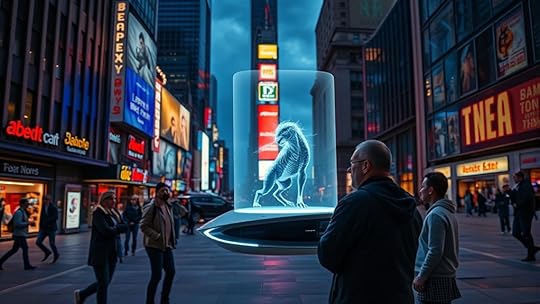
Building on the efforts to use technology to validate legends, future advancements in time-travel verification hold the potential to revolutionize our understanding of history and reality. With breakthroughs in quantum entanglement, you might soon confirm events across timelines instantly, bypassing traditional limitations. However, verifying past events raises concerns about temporal paradoxes, where changes could ripple through time unpredictably. As technology develops, you could explore historical mysteries more directly, but risks remain, like creating alternate realities. The broader implications include reshaping historical narratives, ethical debates about altering the past, and the possibility of discovering hidden truths. Ultimately, these advances could uncover new dimensions of knowledge—but also challenge your perception of reality’s stability.
Confirm legendary events firsthandUnderstand historical inaccuraciesPrevent or cause temporal paradoxesRedefine our grasp of realityNavigate ethical dilemmas in time travelFrequently Asked QuestionsCould Time Travel Inadvertently Alter Historical Events or Timelines?You wonder if time travel could inadvertently alter historical events or timelines. If it does, causal paradoxes might occur, disrupting the natural order. To prevent this, many theories suggest mechanisms for timeline preservation, stopping changes from spreading or affecting the past considerably. While fascinating, these ideas highlight the risks of unintended consequences, emphasizing the importance of strict controls and understanding before exploring time travel’s true potential.
What Safeguards Would Prevent Misuse of Time-Travel Verification Technology?Imagine a clock that ticks only in the right direction—that’s how safeguards work for time-travel verification tech. You’d implement strict ethical oversight, ensuring responsible use and preventing misuse. Privacy concerns would be addressed with encrypted data and access controls, so personal info stays protected. These measures act like a safety net, catching any misuse before it happens, giving you confidence in exploring history without risking chaos or privacy breaches.
How Accurately Can We Date or Authenticate Historical Urban Legend Evidence?You can achieve high accuracy in authenticating historical urban legend evidence through advanced artifact authentication techniques and meticulous evidence preservation. By analyzing material composition, stratigraphy, and contextual data, you verify the age and origin of artifacts. Combining scientific methods with preserved evidence helps you determine authenticity, making it possible to distinguish genuine historical claims from myths or fakes. This approach provides a reliable way to validate urban legends with scientific precision.
Are There Legal or Jurisdictional Issues With Time-Travel Investigations?Did you know that over 60% of legal experts highlight the complexity of legal complications in innovative fields? When exploring time-travel investigations, you face jurisdiction conflicts and legal hurdles because current laws don’t address temporal travel. You must navigate these legal complications carefully, as jurisdiction conflicts could delay or derail your efforts. Understanding these issues is essential for ensuring that your time-travel experiments stay within legal boundaries and avoid future disputes.
How Would Society Respond if a Legendary Event Was Conclusively Proven?If society confirms a legendary event as historically credible, you’d see a major cultural impact, reshaping beliefs and historical understanding. People might debate its authenticity and significance, leading to renewed interest in related stories. You’d also witness shifts in education and media, as the event’s validation changes perceptions. Overall, society would grapple with integrating this newfound knowledge, balancing skepticism with curiosity, and redefining what’s accepted as truth.
ConclusionImagine finally unraveling those age-old legends with a flick of a time machine, only to realize some stories are better left as mysteries. You chase the truth across centuries, but perhaps it’s the uncertainty that keeps history alive. Ironically, the quest to verify legends might just prove that some tales are timeless precisely because they can’t be proven—making the mystery all the more enchanting. After all, isn’t that what legends are really about?



